Interactive Beef Carcass
Click on a Primal Cut to view Sub-Primal Cuts
Ponderosa Hip
Ponderosa Hip
NAMP #166B
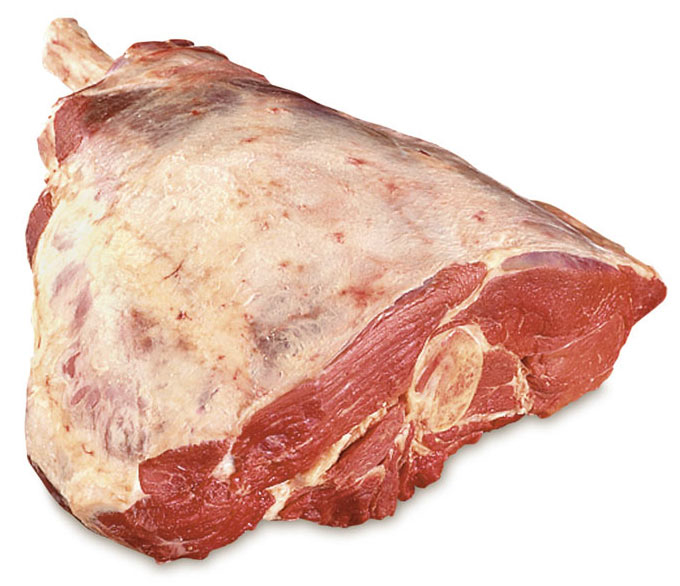
Technical Description – Ponderosa hip is made from a short cut hip with its aitch bone and rough rump removed. The shank bone is cut below the tarsal joint and the shank meat is removed to within 50 mm (2″) of the stifle joint. All loose tissue is trimmed off, and the fat cover does not exceed 6 mm (1/4″) at any one point. The Ponderosa hip weighs between 17 – 20 kg (37 – 44 lb).
This large beef cut is less common today, and is not readily produced in federal meat plants, but may be available from provincial packers. The Ponderosa hip cut of beef is most often used on high-volume buffets largely for its presentation value. The aitch bone on the bottom of the hip is removed for easier carving.
The Ponderosa Hip and the Baron of Beef are not often used in retail operations, but you may get requests for these cuts from retail customers who are planning large parties or events. It would be important to let customers know that custom orders like this take a certain amount of time to fill, since obtaining the product requires a special relationship with a distributor or abattoir.
Other trim options:
Hip [Baron of Beef] Bone-in – NAMP #160C
Hip [Baron of Beef] Boneless – NAMP #161B
Cooking Methods
Roasting
Applications
Roasts
Eye of Round
Eye of Round
NAMP #171C
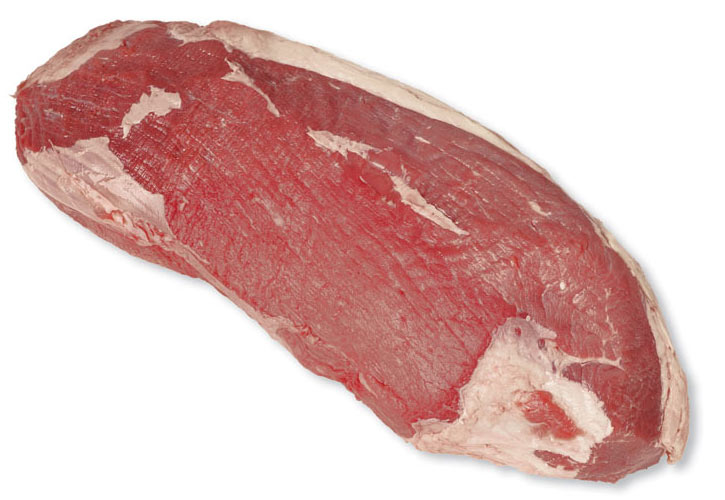
Technical Description – Eye of round is comprised of the semitendinosus muscle, which is produced by separating the eye of round from the inside and outside rounds, and the heel between the natural seams. Eye of round weighs between 2.5 – 3.5 kg (5.5 – 7.7 lb).
Eye of round possesses an attractive price point, and given its leanness, is excellent for roast beef deli- style sandwiches, traditional roast beef dinners and healthcare combination cooking applications.
The eye of round is an inexpensive section of the beef carcass and very easy to process in Retail meat operations. There is very little yield loss when processing into roasts and steaks or even value-added peppered or marinated steaks. When processing the eye of round into steaks, use thin slicing to offset the tight texture. It is also beneficial to use on-pack labels to inform the customer that marinating is required prior to cooking.
End pieces from this section that are not used for steaks or roasts can be used for beef cutlets or stir fry pieces. It should be noted that beef stir fry and cutlets (pounded with a mallet or tenderized with a tenderizing machine) usually sell for a higher retail price than eye of round roast or eye of round steaks.
If you have an opportunity to educate a customer on how to cook and carve this product as a roast, recommend dry heat roasting and always carving these roasts thin after they have been rested. This is sound advice for any of the roasts that are obtained from the hip section.
Sliced paper thin, eye of round is often used for Chinese fondue at retailers for seasonal sales during Christmas and Chinese New Year in Canada. For best results, partially freeze the eye of round before slicing for that consistently thin profile. It would be important to upcharge at least twice the regular price for this product due to the extra labor and time involved in manufacturing.
Cooking Methods
Roasting
Braising/Simmering
Applications
Roasts
Resources
Outside Round Bottom Round Tech Sheet (Including Eye of Round)
Inside Round (Top Round)
Inside Round (Top Round)
NAMP #168
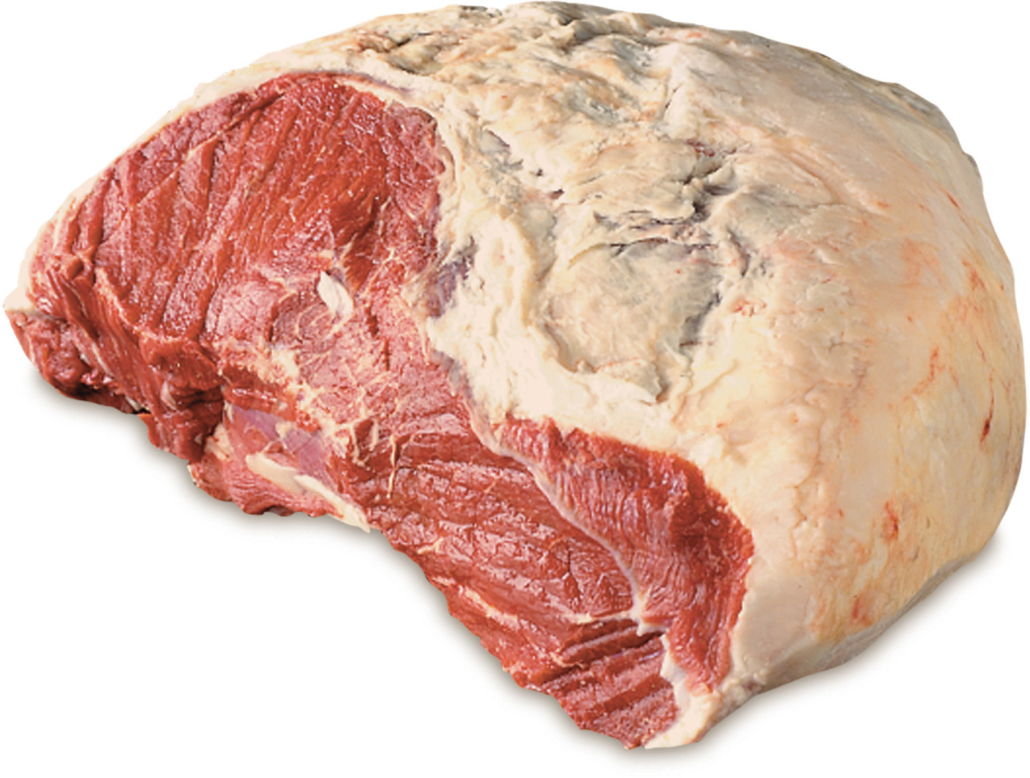
Technical Description – Inside round (top round) is prepared from the inside portion of the hip that is posterior to the round bone. The thick membrane is removed and surface fat is trimmed to a maximum 6 mm (1/4″) at any one point. Inside round (top round) may be split and tied, or netted. Inside round weighs between 9 – 11 kg (20 – 24 lb).
Inside round (top round) is a large muscle and may be roasted whole. The beef cut is ideal for buffets, and is often used for more casual roast beef applications like beef on a bun. Inside round will not replace the middle cuts for tenderness, but is ideal if the goal is to supply a less costly product at an excellent price point. Inside round’s overall price point and numerous retail cut options make it an excellent choice for many retail merchandising opportunities.
Inside round is best cooked in dry heat or combination roasting applications.
Roulades from the round section are often cut from the leanest section of the inside muscle to about 3 mm (1/8″) thickness on a meat slicer.
End pieces from the inside can be utilized for stir fry and tenderized beef cutlets in the meat counter. These are options that can create higher margins for your operations and a point of differentiation for your meat counter.
Some retailers have become creative with the cap muscle from the inside round by using a tenderizing machine to create a cutlet, and then stuffing the cutlet with other foods such as sausage, cheese, and spinach, thus creating either signature roasts or stuffed medallions of beef.
End cuts from the inside round are also sometimes cut for extra lean stew. For some excellent ideas on how to merchandise the hip inside round, check out the Spec Sheets and open up the Video for Merchandising the Inside Round for Retail Operations.
Please reference the Inside Round Tech Sheet for cutting, grinding and carving suggestions, as well as handling tips and menu application opportunities.
Other trim specification options:
Inside (Top Round) Cap Off – NAMP #169A
This beef is completely denuded with the cap off, which results in a higher price point offset by better yield and less work for the meat cutters in Retail Meat Operations..
Cooking Methods
Grilling
Sauté/Pan Fry
Oven Roasting
Braising, Simmering, Stewing or Pot Roasting
Rotisserie
Applications
Roasts
Inside Round Top Round Tech Sheet
Outside Round (Bottom Round)
Outside Round (Bottom Round)
NAMP #170

Technical Description – The outside round flat is produced by separating it from the inside round, sirloin tip, eye of round, heel of round and the shank between the natural seams. The outside round flat weighs between 6.0 – 7.5 kg (13 – 16 lb).
Outside Round Flat NAMP #171B is sometimes called the silverside, bottom round or bottom flat.
The outside round flat has an economical price point and can be used both as a dry-heat roast and as a braising roast.
Outside round flat (or bottom round flat) is a very high yielding cut of beef when handled and cooked correctly, and is a great option for all roast beef applications, including sandwiches.
The hip outside round is an inexpensive section of the beef carcass and it is underutilized by many retailers. With a little bit of work and basic butchery understanding, you will find excellent options to increase the product mix in your meat case.
By removing the side muscle and following grain directions, a progressive retail meat operator can manufacture some great options for their customers. These options would include 0.5 kg (1 lb) quick roasts or rotisserie-style roasts, beef bacon-added roasts or fat-added roasts, thin sliced marinating steaks and extra lean stew (upcharge). The end cuts from the outside can be used for tenderized hip cutlets and stir fry.
Another option at retail is to use the lean heart of the outside muscle and slice across the grain for hip roulades.
The trim from all of the hip cuts can be used in your operations as source grind products in the meat case or for value-added products in your hot deli counter. To create an upsell over commodity products these value-added products may be labeled as Ground Round.
Remember that only cuts from the hip can legally be called Ground Round so the trim would have to be segregated if being sold as Ground Round products. As a good manufacturing practice, aged trim is not recommended for use in lean ground beef for retail sale. Since there is age on the product it will limit shelf life once packaged in the meat counter or stored at home by the consumer.
For some excellent insight on how to merchandise the outside round, please look through the Outside Round Technical Sheets and view the Retail Merchandising Video for the Outside Round.
Cooking Methods
Roasting
Applications
Roasts
Sirloin Tip (Knuckle)
Sirloin Tip (Knuckle)
NAMP #167A
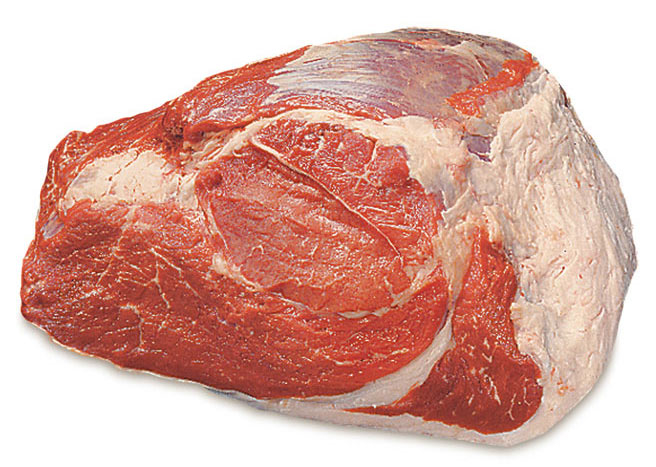
Technical Description – Sirloin tip (knuckle) is prepared from that portion of the short hip that is ventral to the hip bone. The kneecap and surrounding heavy connective tissue are removed. Sirloin tip may be tied or netted. Sirloin tip weighs between 3.0 – 4.5 kg (6.5 – 10 lb).
NAMP #167A has the flank cap muscle removed. NAMP #167 has the flank cap muscle left on and is less common in foodservice.
Do not confuse the sirloin tip with the top sirloin. Sirloin tip and top sirloin look somewhat alike and have a similar weight range, but sirloin tip, or knuckle, is a leg cut and is tougher because it has more connective tissue and grains running in various directions. Top sirloin is a tender, middle muscle.
Sirloin tip has an attractive price point and is best roasted whole in dry heat. If cooked this way, remember to remove the heavy gristle at one end of the knuckle.
Retail meat specialists should realize that there are three main muscles that run through the sirloin tip and, to get best results with the sirloin tip, it is important to seam these three muscles and create opportunities with each section of the sirloin tip. When properly seamed and cut across the grain, there are opportunities to create innovative merchandising with the sirloin tip such as quick roasts, rotisserie style roasts and even sirloin tip medallions.
As with all of the hip cuts, tenderized hip cutlet, stir fry and extra lean stew can be sourced from the sirloin tip. The sirloin tip has an attractive price point and with a little work, can create profit opportunities for a creative retail meat operator.
Please look through the Sirloin Tip Knuckle Tech Sheet to help you understand retail merchandising opportunities with the sirloin tip to help you understand how to process this section in a different manner than you might be accustomed to processing it.
Adding pack instructions on the label of products from the sirloin tip, such as how to marinate the steaks to help tenderize them, will provide an improved eating experience since the tip is not as tender as a middle cut.
Grain direction is important because carving across the grain facilitates shorter muscle fibres and creates a tender final product.
Cooking Methods
Roasting
Pot Roasting
Stewing
Braising/Simmering
Applications
Roasts
Resources
Sirloin Tip Knuckle Tech Sheet
Sirloin Tip Steak, Side Steak
Sirloin Tip Steak, Side Steak
NAMP #1167F
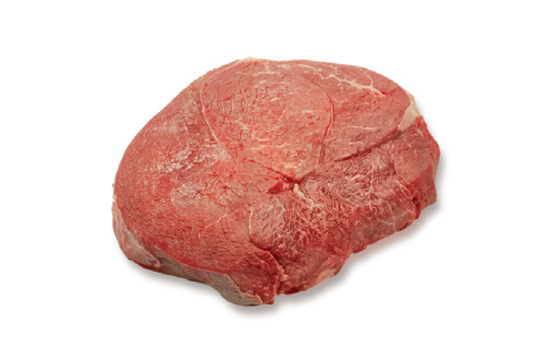
Technical Description – The sirloin tip steak, or side steak, is prepared from NAMP #167F, Sirloin Tip [Knuckle], Side Roast by cuts across the grain or at right angles.
The sirloin tip steak is often referred to as the “eye of sirloin” tip. Cut thinly, a sirloin tip steak makes a good substitute for a top sirloin breakfast steak at a more affordable price.
Sirloin tip steaks should be placed in a marinade prior to cooking to break down the connective tissue.
The customer must specify size, weight and thickness of steaks and be aware that price point will increase with higher levels of trim (from NAMP #167 through NAMP #1167F).
Other sirloin tip steak options:
Sirloin Tip [Knuckle] Steak – NAMP #1167
Sirloin Tip [Knuckle] Steak Peeled – NAMP #1167A
Sirloin Tip [Knuckle] Steak Peeled, Special – NAMP #1167E
Cooking Methods
Roasting
Pot Roasting
Stewing
Braising/Simmering
Applications
Roasts
Resources
Sirloin Tip Knuckle Tech Sheet
Braising Steak, Swiss
Braising Steak, Swiss
NAMP #1102
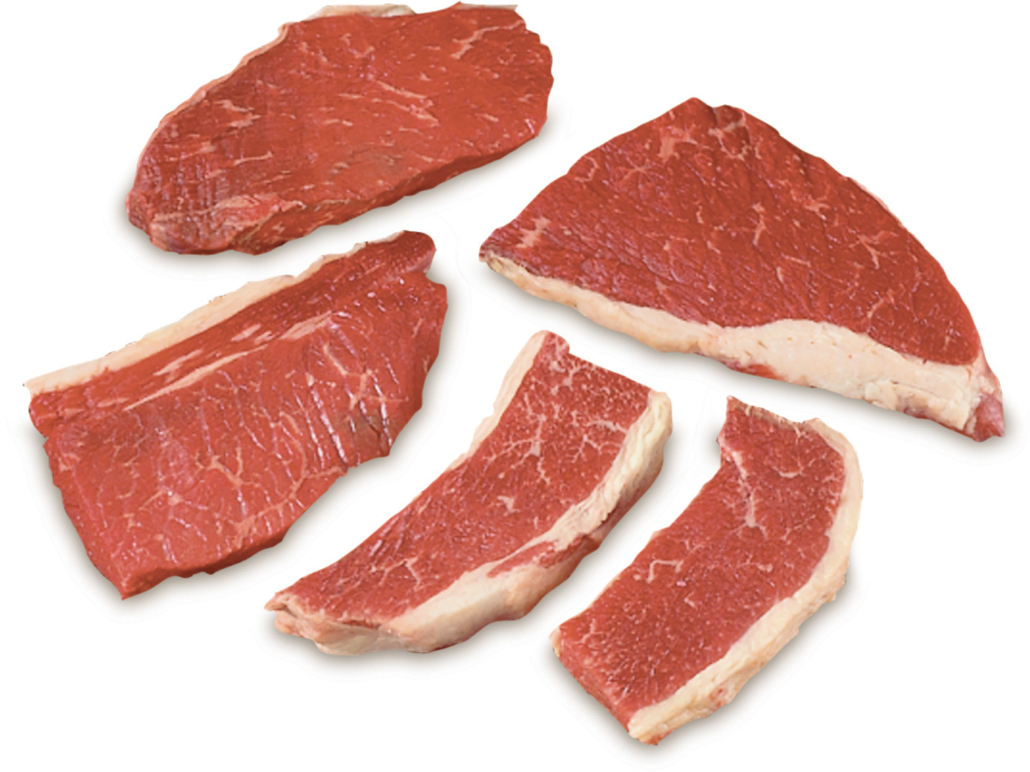
Technical Description – Braising, or Swiss, steak is prepared from any solid muscle derived from primal cuts that is reasonably free of tendons, ligaments and membranous tissue. Cubing, delectating or knitting is not permitted.
These steaks are usually braised in a pot of stewed tomatoes, mushroom sauce, or some other sauce, either on a stove or in an oven.
Cooking Methods
Braising/Simmering
Applications
Steaks
Resources
Outside Round Bottom Round Tech Sheet (Including Eye of Round)
Beef Marinating Strips
Beef Marinating Strips
NAMP #612
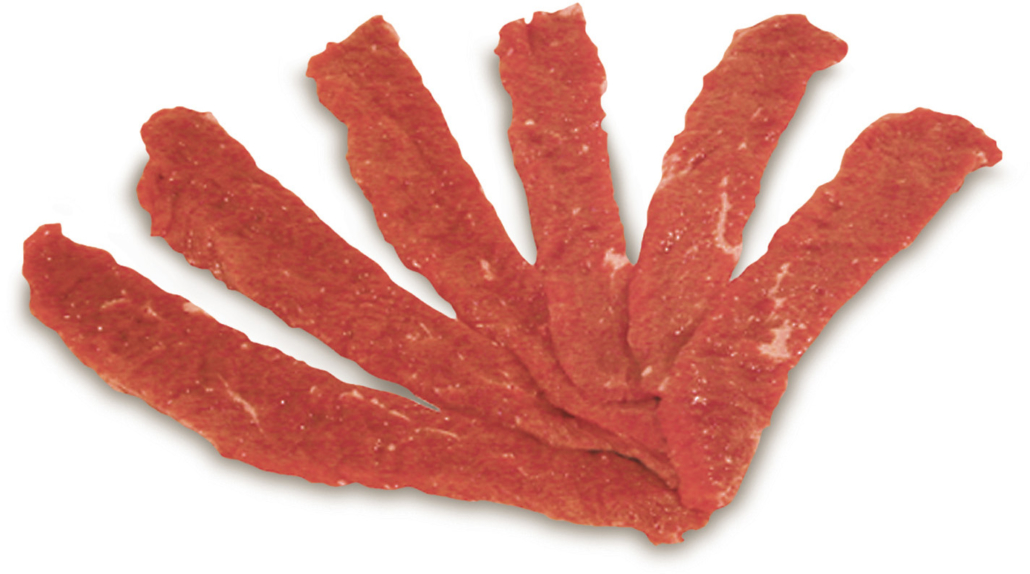
Technical Description – Beef marinating strips may be produced from any raw skeletal portion of the beef carcass with the exception of the cutaneous, shank and heel meat portions. The meat shall be free of fat and be seasoned or marinated.
This product is widely known as fajita strips.
Cooking Methods
Sauté/Pan Fry
Applications
Stir Fry
Fajita
Salads
Pizza Topping
Appetizers
Wraps
Resources
Outside Round Bottom Round Tech Sheet (Including Eye of Round)
Top Sirloin Butt Boneless
Top Sirloin Butt Boneless
NAMP #184
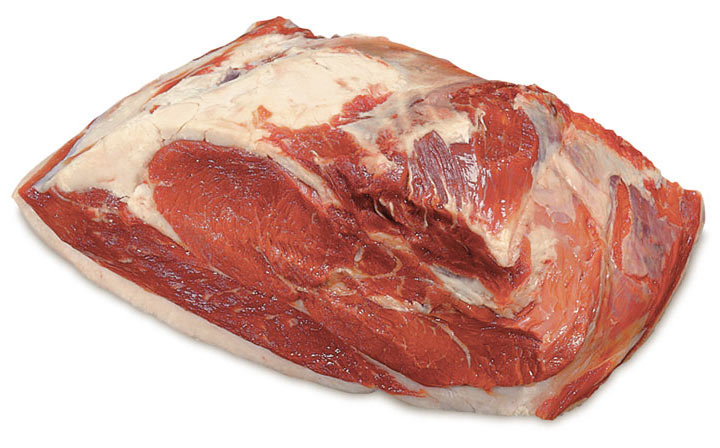
Technical Description – Boneless top sirloin butt is prepared from the thick upper portion of the sirloin butt. The cap is trimmed to an average fat cover of 6 mm (1/4″). The lean side is trimmed of all fat in excess of 6 mm (1/4″). The heavy white membrane adjacent to the sacral vertebrae and all ragged edges are trimmed off. The top sirloin weighs between 4 – 7 kg (9.0 – 15.5 lb).
Top sirloins are supplied individually vacuum sealed and usually packed 5 per case.
The NAMP #184 Top Sirloin is sold with the sirloin cap muscle, or “coulotte,” muscle attached. This specification may not be a good option for an operator with no butchery experience, as they may not be aware that the grain on the cap muscle runs in another direction. Tough steaks will result if this muscle is cut incorrectly.
The top sirloin is a cost-effective option for the Retail Meat Case. The sirloin is the least expensive of the middle cuts and can be utilized in many traditional and non-traditional merchandising opportunities.
Let us explore these opportunities as well as look at different specifications for ordering the top sirloin section.
Other trim specifications options:
Top Sirloin, Semi-Centre Cut, Boneless – NAMP #184A
• Top sirloin cap muscle (coulotte) has been removed in this specification
Top Sirloin, Centre-Cut, Cap Off, Boneless – NAMP #184B
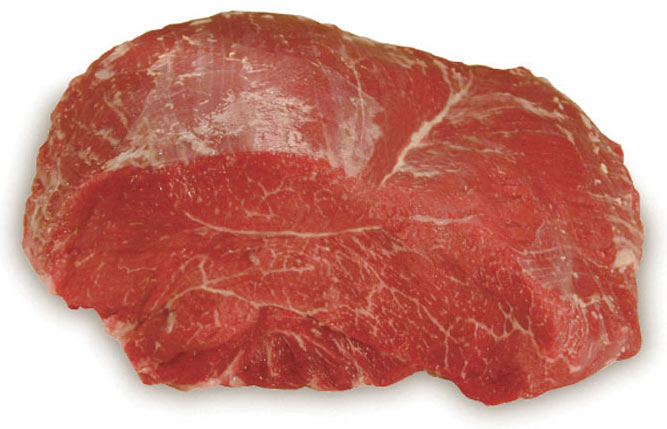
• This is a completely denuded top sirloin butt with all fat as well as the cap removed. This is a great option for a meat operation that has less-skilled meat cutters, since it eliminates the risk of the cap being sliced with the grain when creating steaks or roast offerings.
• As previously stated, the price point of this beef cut, as with other beef cuts, increases with the amount of trimming that needs to be done at the fabrication plant.
Cooking Methods
Grilling
Sauté/Pan Fry
Oven Roasting
Rotisserie
Applications
Steaks
Roasts
Strips for Stir Fry
Resources
Top Sirloin Steak
Top Sirloin Steak
NAMP #1184B
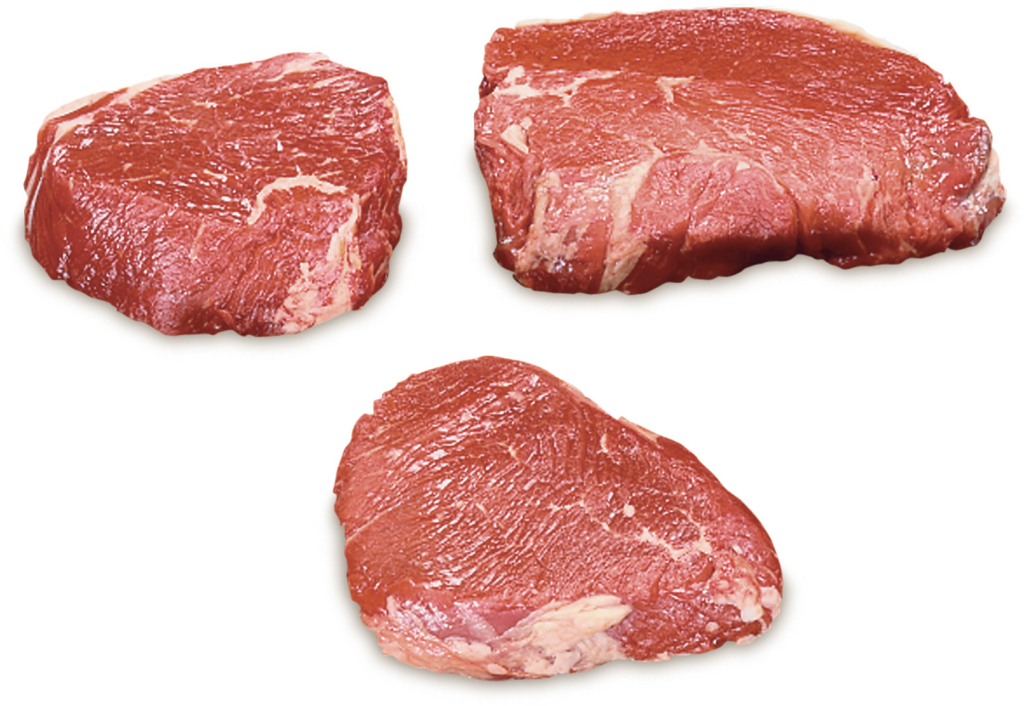
Technical Description – Top sirloin steak is prepared from a top sirloin butt, boneless with fat cover averaging 6 mm (1/4″). Excess membrane on the underside is removed. A facing (a cut made to even off the “face” of a steak cut prior to portioning) is made to exclude excessive connective tissue on the round end. Available as regular or centre cut.
Cooking Methods
Grilling
Applications
Steaks
Resources
Top Sirloin Medallion
Top Sirloin Medallion
NAMP #1184F

Top sirloin medallions are commonly referred to as “Baseball Cut.”
The top sirloin medallion is smaller in circumference but cut thicker to help reach preferred cooking doneness levels and customer price point. Medallions are achieved by splitting the sirloin into three equal sections cut across the grain and then tying into 25 – 50 mm (1 – 2″) steaks across the grain. Some retail meat operations tie or net these medallions to add visual appeal to the steak and create uniformity in cooking. Medallions will perform better on the grill with less chance of overcooking by the retail meat customer. These steaks have an excellent price point even when upcharged from a regular sirloin steak.
Another option with the top sirloin is to leave the roasts intact and sell them as rotisserie-style roasts – which meets the needs of today’s consumers from both a price point and ease-of-carving perspective. The strings or the netting, as well as the shape, will help the customer to make the right decision on how to carve this roast. Creating roasts that are similar in shape (cylindrical) will create a finished product that is cooked evenly throughout.
Misshaped open-face roasts are not as attractive, are harder to carve, and will not cook as evenly due to the uneven shape. Usually these roasts are much more expensive since they are heavier in weight. Also, the resulting higher price point can result in lost sales.
Cooking Methods
Grilling
Applications
Steaks
Resources
Top Sirloin Cap (Coulotte)
Top Sirloin Cap (Coulotte)
NAMP #184D
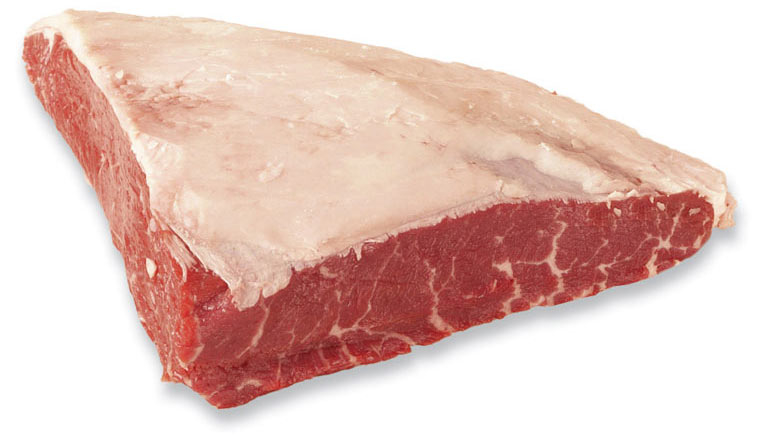
Technical Description – The top sirloin cap consists of the biceps femoris muscle (cap muscle). Purchasers may specify the exterior fat trim desired. The top sirloin cap muscle weighs between 0.7 – 1.2 kg (1.5 – 3.3 lb).
Top sirloin caps are supplied individually vacuum sealed, packed 10 – 15 caps per case.
The price point on the top sirloin cap is better than most middle cuts, which makes the top sirloin cap an excellent option for the foodservice operator.
Top sirloin cap offers many varied menu application opportunities such as top sirloin roast, sandwich steaks, salad topper, kebabs, fondue or stir-fry dishes. Top sirloin cap is also used extensively for ethnic menu options like Brazilian BBQ.
Cooking Methods
Grilling
Sauté/Pan Fry
Applications
Steaks
Roasts
Strips for Stir Fry
Resources
Top Sirloin Cap Steak
Top Sirloin Cap Steak
NAMP #1184D

Technical Description – Top sirloin cap steak is prepared from a top sirloin cap item. The boneless top sirloin cap steak is produced by slicing at an approximate right angle to the grain or in the direction of the muscle fibres.
Top sirloin cap steaks look and perform very similarly to strip loin steaks, but are not as large. Top sirloin cap steaks are ideal for steak sandwiches or breakfast steaks.
Cooking Methods
Grilling
Sauté/Pan Fry
Applications
Steaks
Strips for Stir Fry
Resources
Bottom Sirloin Flap Meat
Bottom Sirloin Flap Meat
NAMP #185A

Technical Description – Bottom sirloin flap meat consists of the obliquus externus abdominis, but may contain the obliquus internus abdominis and tranversus abdominis. The boneless flap is separated from the ball tip and the tri-tip through the natural seam. The heavy connective tissue and any cartilage are excluded.
Bottom sirloin flap meat, usually referred to as just flap meat is supplied in vacuum sealed bags weighing approximately 9 kg (20 lb), packed 2 – 3 bags per case.
Bottom sirloin flap meat is a coarse-grain muscle that contains a high degree of marbling. Bottom sirloin flap meat is another hidden gems of the beef carcass. The grain is consistent on the bottom sirloin flap so it is easy to process.
The bottom sirloin flap meat may be marinated or roasted whole.
Bottom sirloin flap meat and inside and outside skirt meat options are very similar in texture and grain, but bottom sirloin flap meat is larger and may be used as a steak option.
Bottom sirloin flap steak is an excellent menu option. It can be cut into four equal portions with the grain and then cut into steaks by cutting across the grain.
Bottom sirloin flap meat may be trimmed, marinated and then roasted whole and cut thinly across the grain for the traditional Quebec Bavette (Steak Frites) or fajita meat, sliced for salads or used as a bottom sirloin steak option.
Cooking Methods
Grilling
Sauté/Pan Fry
Roasting
Applications
Steaks
Strips for Stir Fry
Sandwich Steaks
Seasoned Skewers
Seasoned Strips
Resources
Bottom Sirloin Flap Meat Tech Sheet
Bottom Sirloin Ball Tip
Bottom Sirloin Ball Tip
NAMP #185B
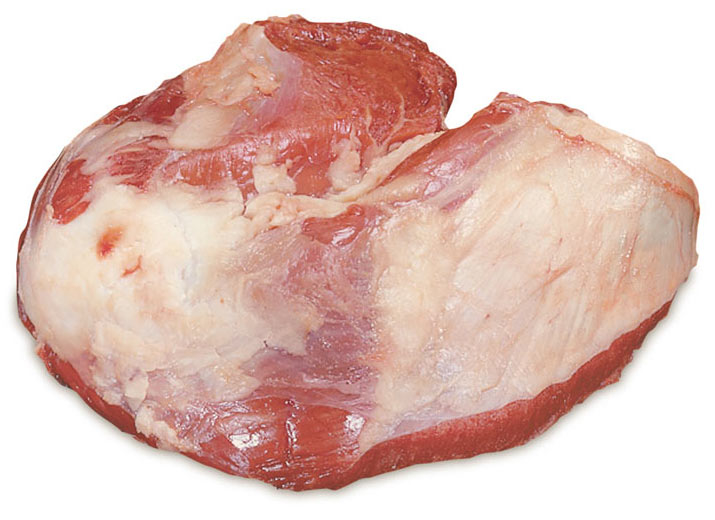
Technical Description – Bottom sirloin ball tip consists of the knuckle muscles in the posterior end of the bottom sirloin butt, removed along the natural seam. Average fat cover does not exceed 6 mm (1/4″). Beef cuts from the bottom sirloin butt represent excellent value and are well suited for foodservice due to their small size and excellent price point when compared to the more expensive middle cuts such as the strip loin and rib eye. Although bottom sirloin ball tip an other bottom sirloin butt cuts don’t yield the same degree of tenderness initially, they yield an excellent steak or roast, if marinated or mechanically tenderized.
Bottom sirloin ball tip works better than the sirloin tip in foodservice since the chef does not have to deal with gristle and connective tissue that is found at the posterior end of the sirloin tip.
Bottom sirloin ball tip requires some butchery experience to separate the muscle along the natural seams to produce a small roast or thin marinating steaks.
Bottom sirloin ball tip is an excellent beef cut for marinating and performs well for stir-fry and cubed for kebabs.
Cutlets may also be produced from the bottom sirloin ball tip and may be mechanically tenderized or pounded into cutlet form with a mallet.
Cooking Methods
Grilling
Sauté/Pan Fry
Roasting
Applications
Steaks
Roasts
Strips for Stir Fry
Bottom Sirloin Ball Tip Steak
Bottom Sirloin Ball Tip Steak
NAMP #1185B
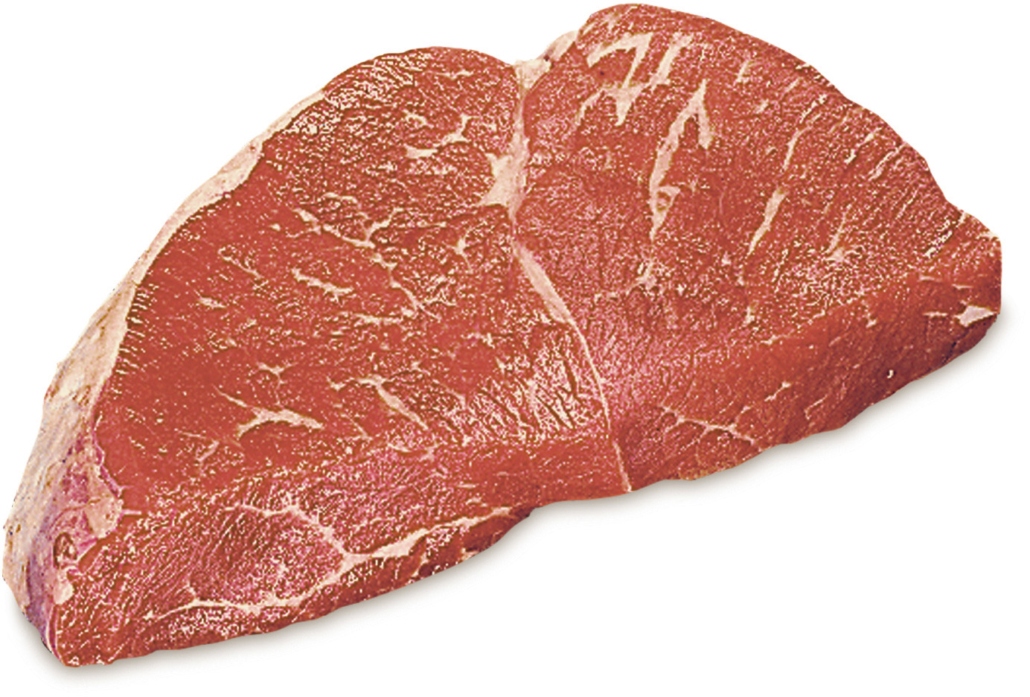
Technical Description – Bottom sirloin ball tip steaks are prepared from the knuckle (a.k.a. sirloin tip) portion of the bottom sirloin butt. The boneless steak is produced by slicing at an approximate right angle to the grain or in the direction of the muscle fibres.
Bottom sirloin ball tip steaks may be marinated, then sautéed or pan-fried.
Cooking Methods
Grilling
Sauté/Pan Fry
Applications
Steaks
Strips for Stir Fry
Bottom Sirloin Tri-Tip
Bottom Sirloin Tri-Tip
NAMP #185C
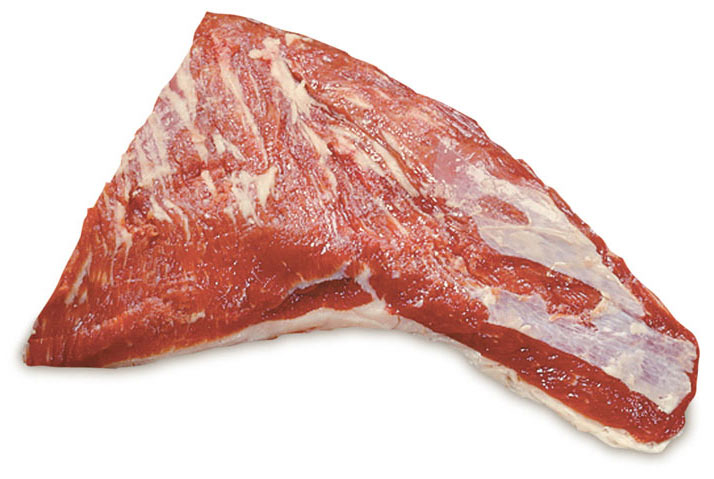
Technical Description – The Bottom sirloin tri-tip consists of the triangular-shaped muscle in the ventral end of the bottom sirloin butt. Average fat cover does not exceed 6 mm (1/4″). The bottom sirloin tri-tip weighs 1.4-2.4 kg (3 – 6 lbs).
Bottom sirloin tri-tips are supplied individually vacuum sealed and are usually packed 10 – 15 per case.
The bottom sirloin tri-tip is a tender and flavourful beef cut with an economical price point that offers a chef — with knowledge of this versatile cut — a point of menu differentiation.
Bottom sirloin tri-tip can be made into a quick roast or cut into grilling medallions.
Bottom sirloin tri-tip performs best when spice rubbed and roasted whole.
Bottom sirloin tri-tip is often used in traditional American BBQ where it is smoked and slow cooked for a long period of time.
A bottom sirloin tri-tip roast must be carved across the grain for best results.
Cooking Methods
Sauté/Pan Fry
Roasting
Applications
Steaks
Roasts
Strips for Skewers and Satays
Bottom Sirloin Tri Tip Steak
Bottom Sirloin Tri Tip Steak
NAMP #1185C
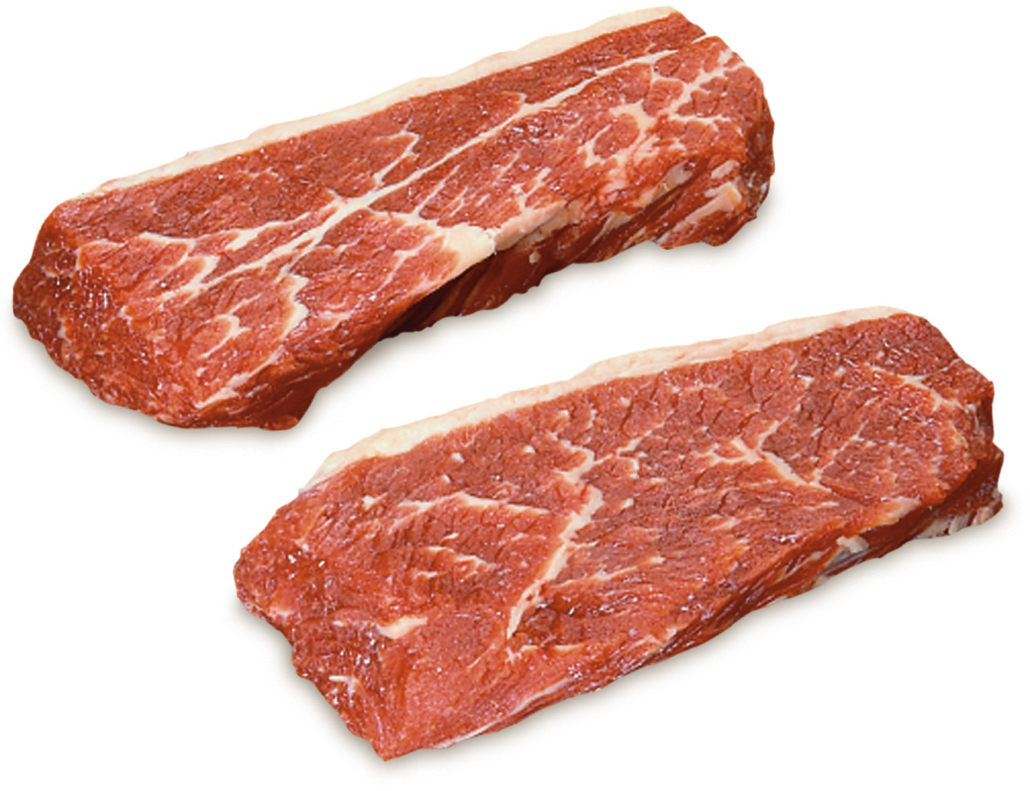
Technical Description – Bottom sirloin tri-tip steaks are prepared from the triangle-shaped muscle of the bottom sirloin butt. The boneless bottom sirloin tri-tip steak is produced by slicing at approximately a right angle to the grain or direction of the muscle fibres.
Cooking Methods
Grilling
Sauté/Pan Fry
Applications
Steaks
Strip Loin
Strip Loin
NAMP #180
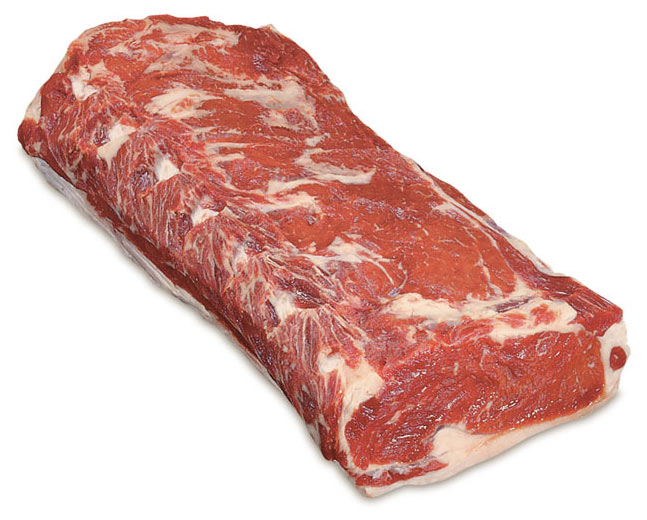
Technical Description – Strip loin is prepared from the anterior portion of the loin with the tenderloin and all bone removed. Average fat covering shall be 6 mm (1/4″). The flank is trimmed off in a straight line, leaving predetermined tail lengths* of 0 mm x 25 mm (0″ x 1″) tail, 25 mm x 25 mm (1″ x 1″) tail, 25 mm x 50 mm (1″ x 2″) tail, and 50 mm x 75 mm (2″ x 3″) tail. The strip loin weighs between 5.5 – 6.5 kg (12 – 14 lb).
*NOTE: The “tail” refers to the amount of beef product that extends from the edge of the loin eye to the end of the loin. Tail length is measured in the following manner: A beef cut with a tail length specified as 3×4 means the tail measures 75 mm (3”) at the loin end and 100 mm (4”) at the rib eye end. Tail lengths are universally stated without units of measure, which are understood to be in inches, such as 2×2; 2×3; 1×2 or 0x0 (i.e., no tail).
Strip loins are supplied individually vacuum sealed and are packed 5 – 6 loins per case.
In addition to the grade of the product, the amount of tail left on a strip loin is reflected in its price points. Generally, the shorter the tail, the higher the price point. Strip loins can be ordered with tail lengths of 1×1, 0x1 or 0x0. Finger and chain meat are either removed or retained and the product can be ordered with back strap off as an option (also resulting in a higher price point).
Prime or AAA-branded strip loin programs are more expensive than AA- or A-graded product. Generally, the more expensive, higher marbled grades (Prime/AAA) are preferred by fine dining or upscale casual segment foodservice operators.
Strip loins should be aged a minimum of 2 weeks before grilling or roasting. Many foodservice operators age their strip loins for up to one month or more.
Dry aging strip loins is an excellent option for product differentiation. Remember that dry aging programs also create a greater yield loss (moisture loss and dark edges have to be removed before processing into steaks and roasts) and menu prices will need to reflect the yield loss.
Proper carving and preparation are essential with this full-muscle product. Otherwise. the operator should consider using a portion control product.
The strip loin yields excellent tender roasts or steaks.
Cooking Methods
Grilling
Sauté/Pan Fry
Oven Roasting
Braising, Simmering, Stewing or Pot Roasting
Applications
Steaks
Roasts
Strip Loin Steak
Strip Loin Steak
NAMP #1180
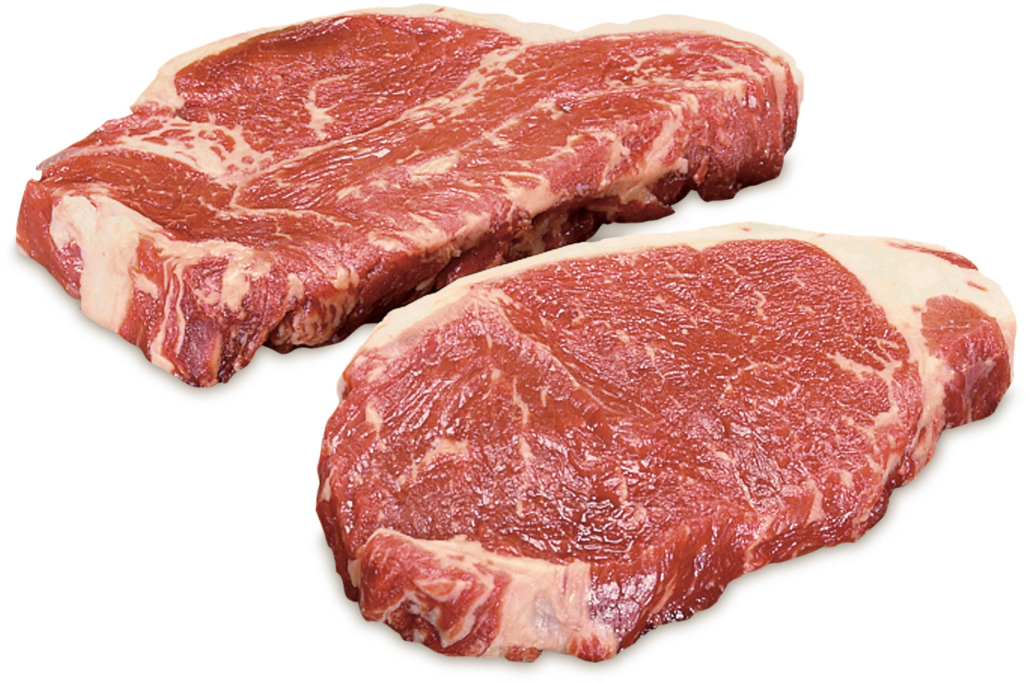
Technical Description – The strip loin steak is prepared from a regular boneless strip loin with the back strap and excessive finger bone tissue and cartilage removed. The fat cover averages 6 mm (1/4″). There is a natural depression on the strip loin (referred to as the Saddle area) where exterior fat coverage will be greater than 6 mm (1/4″). Strip loin steaks are of a uniform thickness and tail length does not exceed 50 mm (2″), although commonly trimmed at 25 mm (1″), as measured from the extreme outer tip of the loin eye muscle.
The strip loin steak has a reputation for being a true menu favorite and is considered by many to be the most popular and versatile of all the steak classics. This steak has an excellent blend of firm texture and fine marbling that delivers exceptional flavour and tenderness. Strip loin steak specialties often include toppings and sauces like peppercorn sauce, wine reductions and seafood blends to add variety to the menu mix. Often recommended to guests looking for a slightly leaner, less rich dining experience.
Cooking Methods
Grilling
Applications
Steaks
Resources
Strip Loin Medallions
Strip Loin Medallions
NAMP #1180B
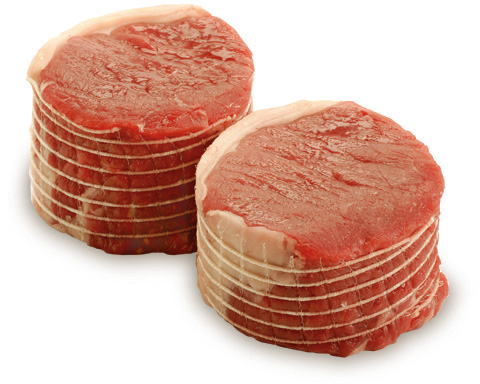
Technical Description – Prepared from a boneless strip loin, the strip loin petite roast is best suited when heavy 6.5 kg (14 lb) and up strip loins are utilized. The tail is trimmed to a 0x0 specification, the back strap is removed and the cut is then evenly split lengthwise to produce 2 split strip loins, which can then be effectively portioned into small (petite) roasts, medallions or steaks.
Medallions are a unique and innovative approach to the changing appetites and lifestyle choices of guests looking for a great steak experience. They are a perfect menu choice for extending a premium steak program into the lunch trade or as an innovative signature item for the dinner menu.
Beef is up to 16 % larger than it was 20 years ago and this is reflected in larger strip loins. The advantage to split strip loin roasts and medallions is that thicker 160 – 180 gram (6 – 8 ounce) steaks can be cut from the split sections. This creates a steak that is easier to grill to a rare or medium rare doneness. Split strip loin roasts are easier to portion with better yield results.
Cooking Methods
Grilling
Oven Roasting
Applications
Steaks
Strip Loin Bone-in
Strip Loin Bone-in
NAMP #175
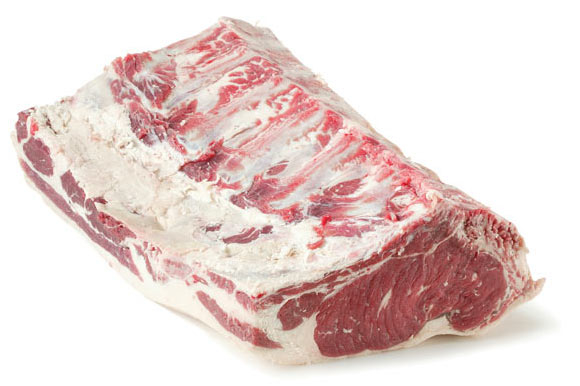
The bone-in Strip Loin may be ordered if the operator has a meat bandsaw for producing bone-in steaks. Bone-in strip loin steaks are a way to create a point of differentiation on a menu, as this is not commonly done. Chefs who are involved in a dry aging program should consider ordering this product, because the meat is protected by the outside fat and the bone, creating a better yield when processed into roasts or steaks.
Cooking Methods
Roasting
Applications
Roasts
Strip Loin Steak, Bone-in
Strip Loin Steak, Bone-in
NAMP #1179
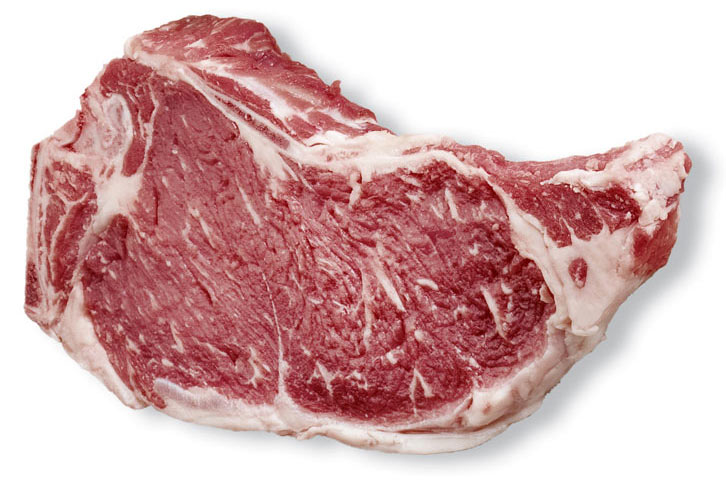
Bone-in strip loin steak is prepared from any beef short loin. The protruding edge of the chine bone shall be excluded so that no portion of the spinal groove is present. The bone-in strip loin steak is often referred to as a wing steak.
Bone-in strip loin steaks may be used to create a point of differentiation on a menu, as this is not commonly done.
Cooking Methods
Grilling
Applications
Steaks
Resources
Short Loin, Short-Cut
Short Loin, Short-Cut
NAMP #174
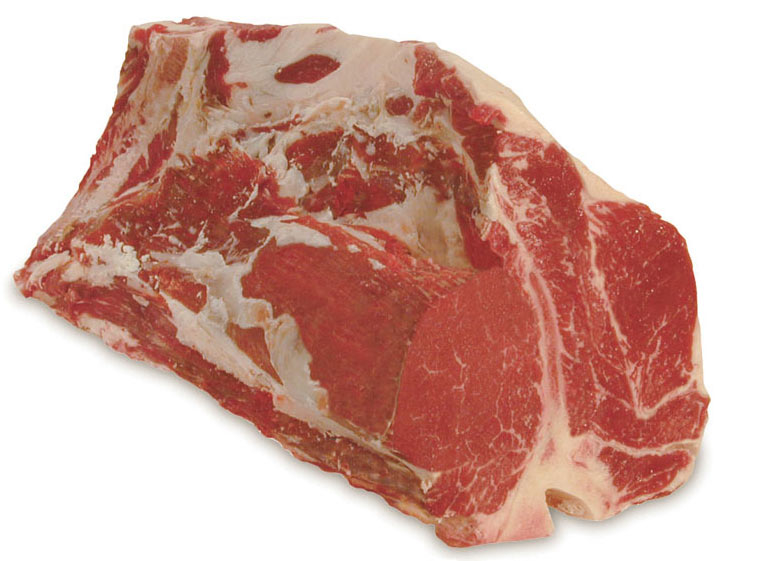
The short-cut short loin includes the strip loin and the tenderloin. Foodservice operators would need a meat bandsaw to produce T-bone, porterhouse and wing steaks.
A traditional steakhouse might ask for this product specification when their chef has butchery experience can produce his own steaks or roasts from the short loin.
Resources
Porterhouse Steak
Porterhouse Steak
NAMP #1173

Technical Description – The porterhouse steak is cut from the large end of the short loin anterior to the gluteus medius and has meat from the strip loin on one side of the bone and tenderloin on the other. The resulting cut gives the porterhouse steak the distinction of having a larger tenderloin portion than the T-bone.
Fat cover may not to exceed 6 mm (1/4″) and tail length may not exceed 50 mm (2″). A porterhouse should maintain not less than 50 mm (2″) of tenderloin at its largest diameter.
Cooking Methods
Grilling
Applications
Steaks
T-Bone Steak
T-Bone Steak
NAMP #1174
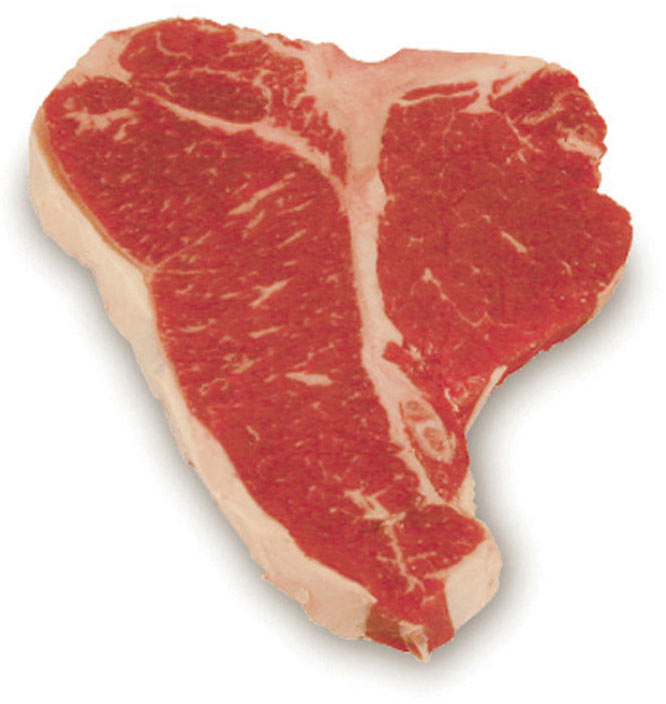
Technical Description – The T-bone steak is cut from the large end of the short loin and has the meat from the strip loin on one side of the bone and tenderloin on the other.
Fat cover may not exceed 6 mm (1/4″) and tail length cannot exceed 50 mm (2″). A T-bone steak should maintain not less than 25 mm (1″) of tenderloin at its largest diameter.
Cooking Methods
Grilling
Applications
Steak
Tenderloin, Full
Tenderloin, Full
NAMP #189
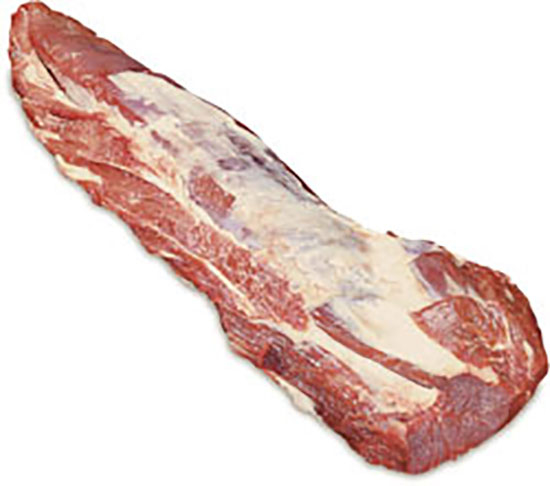
The full tenderloin weighs between 1.5 – 2.5 kg. (3 – 6 lb) and yields premium oven roasts and grilling steaks. The tenderloin may be ordered in several different trim options. However, the price point increases with additional trimming. The NAMP #189 Full Tenderloin is the lowest cost option for tenderloin, but requires a significant degree of butchery skill to prepare it for cooking.
The tenderloin is the most tender section on the beef carcass and is generally the most expensive cut of the beef carcass.
NAMP #189A- Tenderloin, Special Trim Wedge Fat In, Side Muscle On

NAMP #189A is the same as NAMP #189 Full Tenderloin, except that it is practically free of surface fat. The wing fat may remain. This option is a more expensive alternative due to increased trim.
NAMP #190 – Tenderloin, Special Trim Wedge Fat Off, Side Muscle Off
NAMP #190 is as described in item No. 189B Full Tenderloin, Special Trim Defatted, Side Muscle On, except the side muscle, or psoas minor, shall be excluded. In addition, the wing fat (fat lying between the main body of the Tenderloin and the illiacus muscle) shall be removed. The principal membranous tissue over the main body of the tenderloin, or psoas major, shall remain intact. This specification would require a higher price than the first two specifications because of the higher level of trim.
NAMP #190A – Tenderloin Peeled, Side Muscle Off (PSMO)

NAMP #190A is as described in NAMP #190, except the principal membranous tissue covering the psoas major is excluded. This is a premium beef product that requires little work by the chef and so demands a high price.
NAMP #190B – Tenderloin, Full, Side Muscle Off, Centre-Cut, Skinned
NAMP #190B is as described in item No. 190A except that the tenderloin tail (item No. 192A) and butt tenderloin (Item No. 191A) shall be removed. This item is sometimes referred to as a “barrel” cut and is the most expensive specification for whole tenderloin. It might be difficult to source this product because the packer would have difficulty selling the products that are removed to create what would be a centre-cut tenderloin.
Cooking Methods
Grilling
Oven Roasting
Rotisserie
Applications
Chateaubriand
Steaks
Roasts
Butt Tenderloin
Butt Tenderloin
NAMP #191A
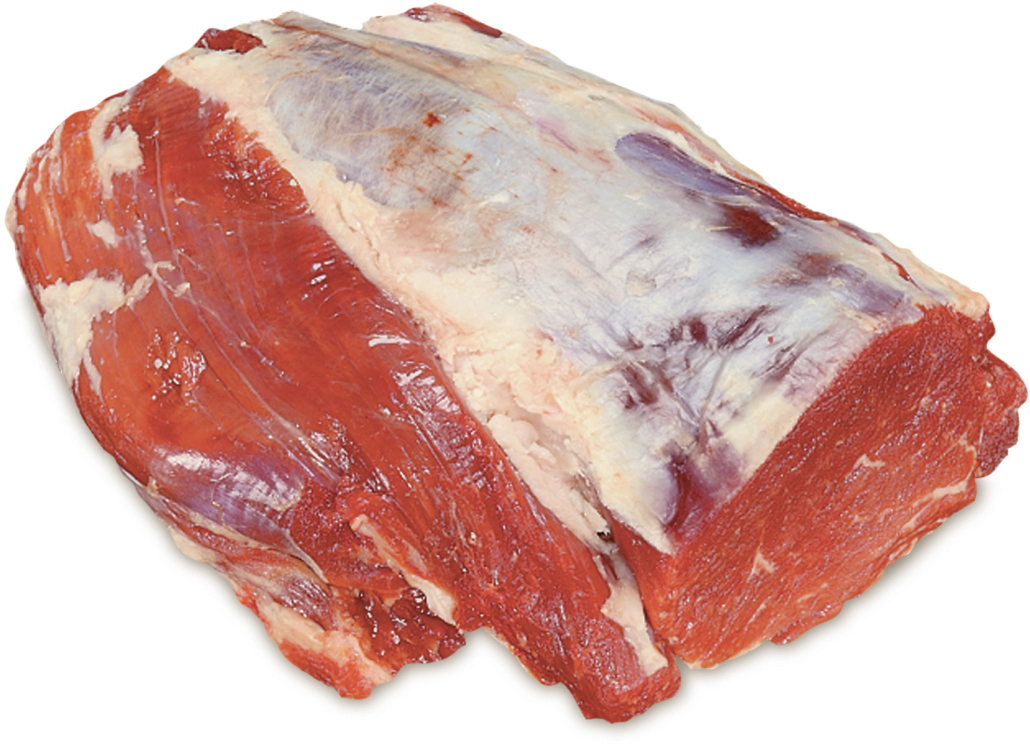
Technical Description – The butt tenderloin consists of the sirloin butt portion of the tenderloin. Surface and wing fat are trimmed practically free. The butt tenderloin is produced when the primal loin is split into the short loin and sirloin butt. When this is done, the tenderloin is cut into two portions. The butt tenderloin has the thick, top part of the tenderloin removed from the sirloin section, and contains the psoas major, psoas minor and illiacus.
Butt tenderloins weigh roughly 1 kg (2 lb) and are supplied 10 – 15 loins per case.
Tenderloin butts may be ordered with increasing levels of trim from NAMP #191 to NAMP #191A and NAMP #191B.
Butt tenderloin is often less expensive than whole tenderloin, which prompts many retailers to choose the butt tenderloin over the whole tenderloin to meet the needs of their meat operations.
Another reason that butt tenderloins are more popular in retail operations is that the tenderloin tip has been removed and is no longer an issue for the retail operation to deal with. The tip end of the whole tenderloin (the last 7 – 10 cm (3 – 4″) creates challenges because decent looking medallions cannot be manufactured from it. That being said, tip ends can be used for kebabs, stir fry and, in some cases, sold as tenderloin tips which unfortunately usually all sell at a lower price than tenderloin roasts or steaks.
Cooking Methods
Grilling
Roasting
Applications
Chateaubriand
Steaks
Roasts
Tenderloin Steak
Tenderloin Steak
NAMP #1190A
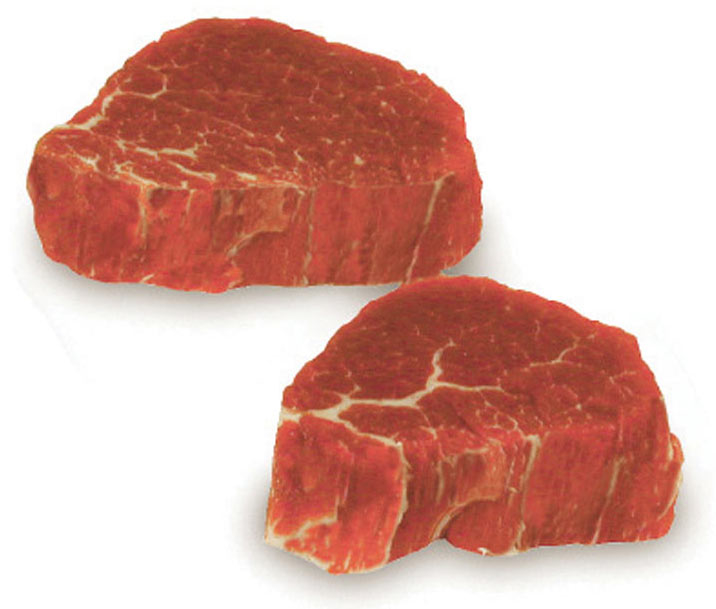
Technical Description – Tenderloin steak is prepared from NAMP #189 Tenderloin, Regular Trim. Fat cover averages 6 mm (1/4″). The individual steaks are cut from a tenderloin with not less than 40 mm (1.5″) of a uniform thickness.
There are various trim specifications available for tenderloin steaks and these increase in cost with the amount of trimming that is required to produce the product.
Trimming silver skin, cutting exact portion steaks and removing the side muscle takes substantial skill and should not be attempted without a comprehensive butchery background. A significant amount of money can be lost if processing mistakes are made with the tenderloin.
Bone-in tenderloin steaks have become increasingly popular and may be difficult to source.
Remember that tenderloin steaks have a limited shelf life. Manufacture only as many steaks as you will need on a daily basis. Another option is to put whole butt tenderloins in the meat case and manufacture steaks after the butt tenderloin has been in the case for one day. This will keep an option of roast style tenderloin for the customers as well as a steak option which will create the potential for increased sales of tenderloin.
Remember that tying the tenderloin for steaks will keep the tenderloin more cylindrical and create a visually appealing, professional looking steak that will cook more evenly when placed on the grill.
Cooking Methods
Grilling
Applications
Steaks
Rib, Primal
Rib, Primal
NAMP #103
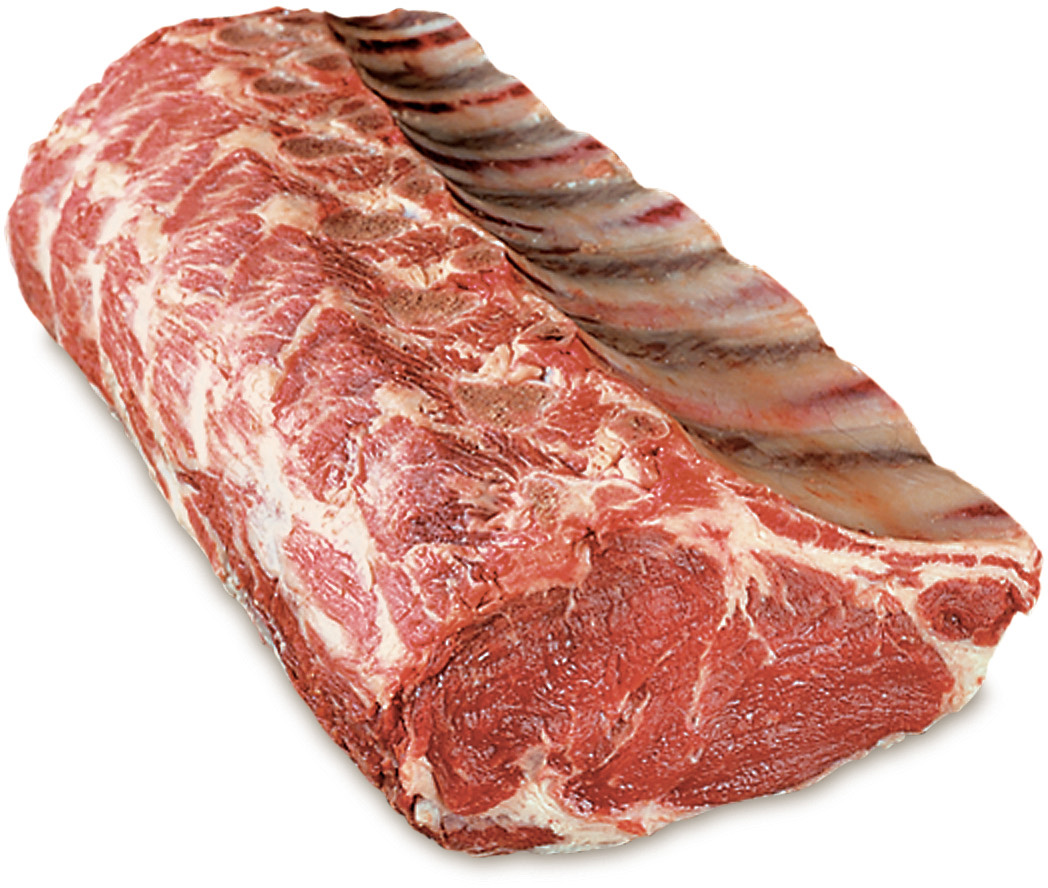
The primal rib originates from the upper back region of the front quarter and represents approximately 5% of a chilled bone-in carcass by weight. The primal rib is separated into two sub-primal cuts including the main rib and the short ribs. Marketable components include: rib, boneless rib, rib eye, back ribs and short ribs. The primal rib weighs between 6.0 – 7.5 kg (13.0 – 16.5 lb).
Many cuts from the primal rib are available in a variety of bone-in and boneless styles and trim specifications.
Note that rib eye roasts and steaks may be produced from the primal rib, as the rib eye is just the main muscle remaining after the tail and bones have been removed. Such removal is relatively easy to do, but does require some butchery skill.
Cooking Methods
Roasting
Applications
Roasts
Rib, Roast-ready
Rib, Roast-ready
NAMP #109
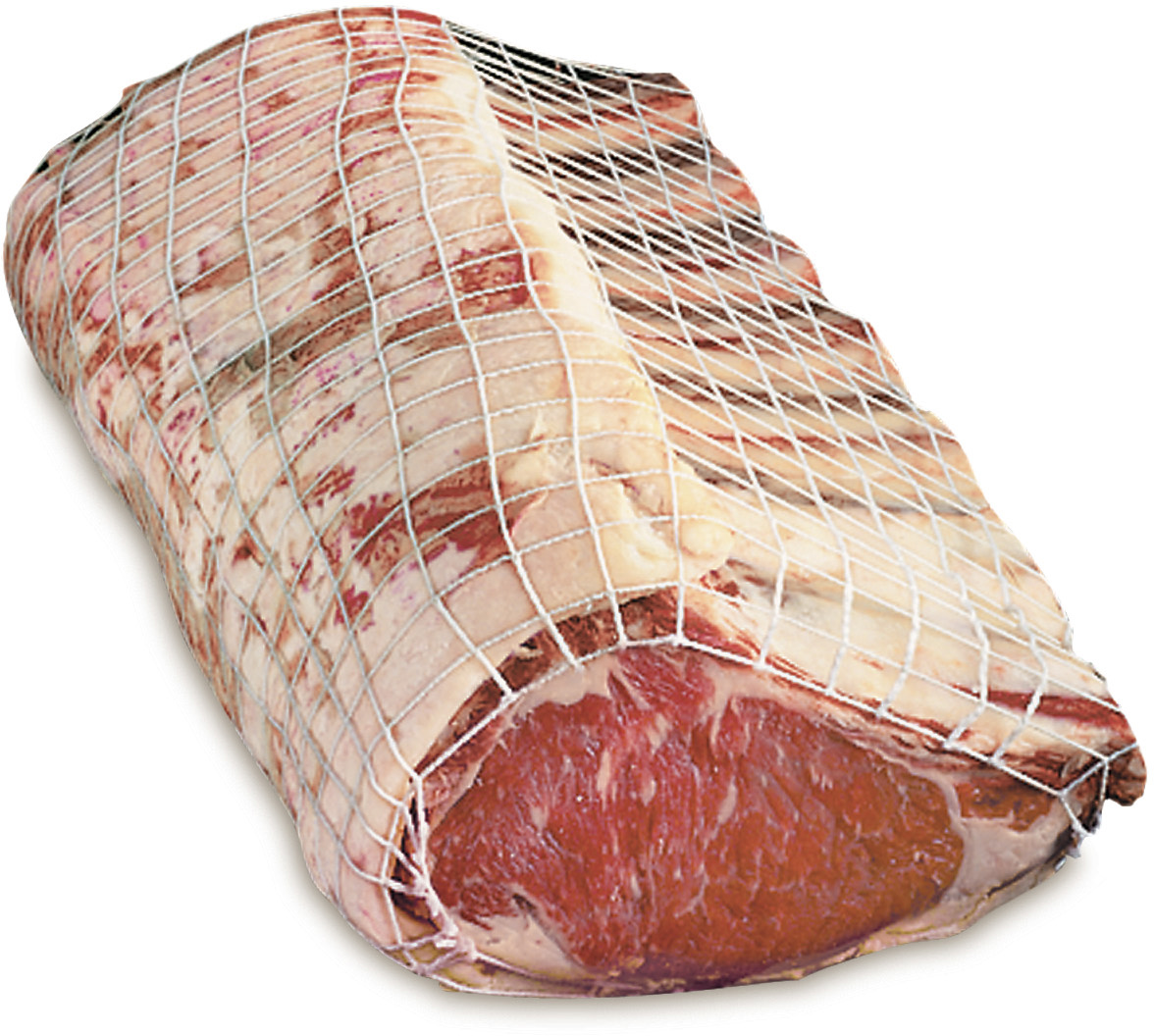
Technical Description – Rib roast-ready is prepared from the primal rib. All bones and cartilage are removed, except the 6th to 12th rib bones. The short rib is cut off in a straight line at the outer edge of the rib eye muscle at both the loin and chuck ends, leaving a predetermined tail length. The back strap is removed and the fat cap is lifted and trimmed to an average of 20% of finished roast weight. The fat cap is replaced, covering the Rib eye’s entire outer surface. It is held in place, string tied or netted. Also known as chef style, deluxe, banquet style, roast ready rib is available as bone-in or boneless.
The tail is the amount of beef product measured from the edge of the rib eye to the end of the tail. Tail length is measured in the following manner: Rib (3×4) has a tail measuring 3” at the loin end and 4” at the chuck end. Tail lengths available for roast ready rib include: 2×2; 2×3; 1×2; 0x1.
Roast-ready rib is not the most popular specification to order in retail markets and is more popular in foodservice. It should be noted that if an opportunity for an attractive price comes from the packer, you might want to order this product as all of the cuts that are described from the rib section can be manufactured from this specification.
Cooking Methods
Grilling
Sauté/Pan Fry
Oven Roasting
Braising, Simmering, Stewing or Pot Roasting
Applications
Roasts
Resources
Rib - FCO (Fat Cap Off)
Rib – FCO (Fat Cap Off)
NAMP #109D
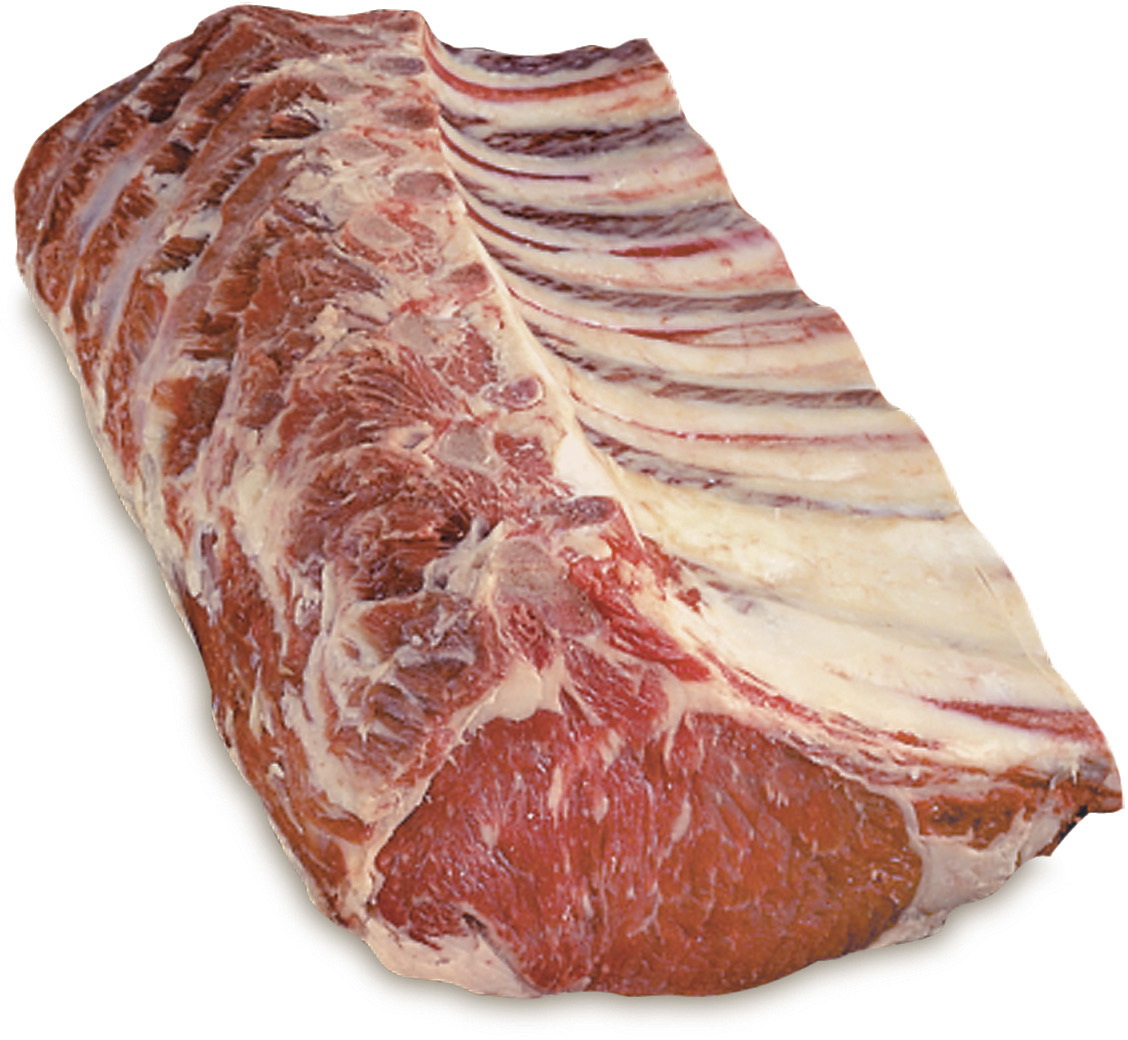
Technical Description – Rib FCO (Fat Cap Off) is prepared identically to the rib roast ready, except that the fat cap is excluded and the remaining fat cover is trimmed not to exceed 6 mm (1/4″) over the lean muscle with beveled edge at the tail. Rib FCO is available as bone-in or boneless with tail lengths of 2×3, 2×2, 1×2 and 0x1. In addition, the short plate shall be further excluded by a straight cut that is ventral to, but no more than 5 cm (2″) from, the longissimus dorsi at the loin end to a point on the chuck end ventral to, but no more than 7.5 cm (3″) from, the longissimus dorsi. Tail not to exceed 2×3.
Rib FCO is also known as “export rib.”
Rib FCO is the most common specification option for bone-in prime rib cuts used in retail meat operations. All of the boneless and bone-in cuts that are sold in retail operations can be achieved from this section. Please go through the technical sheets for the rib and view the video to show some of the cuts that can be achieved from this section of the beef carcass.
You will see the versatility of this cut and you will also see some new generation cut options that might fit into your operations, such as the stuffed spinalis as well as the medallion cuts and rotisserie-style roast.
If you do sell the spinalis at retail as a stuffed product, it would be wise to put a modifier on the name to help with the merchandising appeal, such as Rocky Mountain Rib Eye Roll (Rib Eye Spinalis). This is a great example of a product for the service meat case that would create a point of differentiation from your competitors and would demand a higher price due to the labor involved in its manufacturing.
Remember that if you are manufacturing boneless products from the rib FCO, it will be important to merchandise the back ribs. By putting a simple rub on the back ribs you will be creating a visually appealing, value-added product that should sell well during grilling season or as a braised product in the wintertime.
Many customers consider the rib section to be the most desirable section of the beef animal due to the increased flavour from this well marbled cut. Boneless and bone-in prime rib roasts and steaks, as well as rib eye options, will always be popular with customers.
Holiday times such as Christmas and Easter will see a spike in sales and demand on the rib section. Larger roasts are often sold during these times, used as a celebratory meal around family gatherings. Make sure you meet these demands by having enough stock on hand, aging the product properly before processing and keeping historical records of these sales so that you can forward-buy for the next holiday season.
Cooking Methods
Roasting
Applications
Steaks
Resources
Oven-ready Boneless Rib
Oven-ready Boneless Rib
NAMP #110

Technical Description – Oven-ready boneless rib has the beef back rib bones and finger meat removed. The exterior fat cover shall not extend beyond the short plate edge. Boneless, netted or tied, and tail lengths generally do not exceed 2×2.
Oven-ready boneless rib may also be commonly called “tuxedo ribs” or boneless fat cap on rib.
The option for the oven-ready boneless rib is not often used in retail operations but both the rib eye roll and oven-ready boneless rib are suitable for sourcing boneless rib cuts.
The prudent meat retailer should ask about pricing for both the oven-ready boneless rib and rib eye roll and do yield and profit tests to see which option works out to be most cost effective for their operations. Remember that with oven-ready boneless ribs, the tail is left on and this will generate a little bit more trim than the rib eye roll specification.
Cooking Methods
Roasting
Applications
Roasts
Resources
Rib Eye Roll
Rib Eye Roll
NAMP #112

Technical Description – Rib eye roll is prepared from a capless rib with the rib bones removed by scalping, and tail nearly (1×1) or completely (0x0) trimmed off.
Rib eye roll consists of only the rib eye muscle and is the most expensive option from the rib.
The 0x0 rib eye roll has no tail.
All these options require little butchery skill and can be easily made into steaks, or conveniently roasted.
The more common boneless cut used in retail meat operations is the rib eye roll. The prudent meat retailer should ask about pricing for both the rib eye roll and the oven-ready boneless rib and do yield and profit tests to see which option works out to be most cost effective for their operations. All boneless rib cuts can be obtained from this section with the least amount of work because there is no tail on this section.
Cooking Methods
Roasting
Applications
Steaks
Roasts
Resources
Lip-on Ribeye
Lip-on Ribeye
NAMP #112A
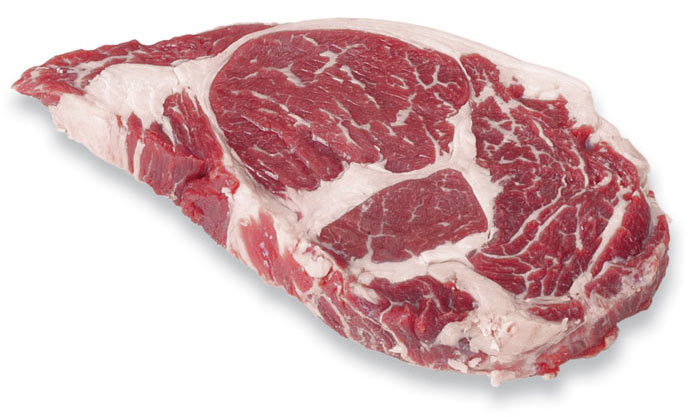
Technical Description – The lip-on ribeye contains the longissimus dorsi, spinalis dorsi, complexus, and multifidus dorsi muscles and a “lip” consisting of the serratus dorsi and longissimus costarum muscles and related intermuscular fat on the short plate side. The lip length is prepared with a straight cut that is ventral, but no more than 5 cm (2″) from, the longissimus dorsi. Lip shall not exceed 5 cm x 5 cm (2” x 2”).
The lip-on ribeye, after confirming through yield testing, might be an option for the retailer if the pricing from the packer is better than the rib eye roll specification.
Cooking Methods
Roasting
Applications
Steaks
Roasts
Resources
Beef Back Ribs
Beef Back Ribs
NAMP #124
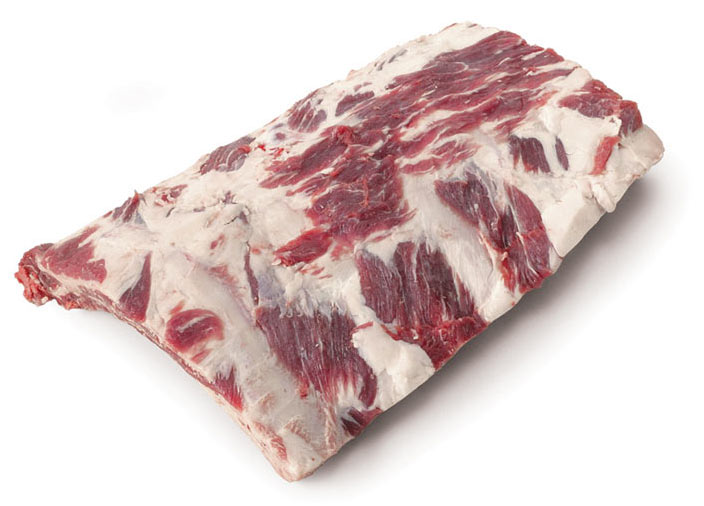
Technical Description – Beef back ribs are the intact portion of the seven ribs (i.e., 6th through 12th ribs) and intercostal meat from a rib. The chine bone and thoracic vertebrae are removed exposing the sawed end of the rib bones. Unless otherwise specified, beef back ribs shall be no less than 15 cm (6″) or more than 20 cm (8″) wide at any point measured across the sawed ends of the rib bones.
Beef back ribs as a centre-of-plate item has emerged from many chefs and consumers using boneless rib products.
Beef back ribs are an excellent product to slow roast with a rub. Many chefs will remove the membrane on the outside of the ribs, apply a dry rub and then parboil or simmer the ribs. The beef back ribs are then finished in the oven or on the grill to achieve a nice colour.
Beef ribs or beef back ribs should be considered as part of the product mix for retailers, especially in the summer time. By slicing the back ribs 6 mm (1/4″) thick on the band saw and putting a simple rub on them, you can create a very simple, value-added beef product for your meat counter.
Meaty back ribs can be obtained if you bone-out your own back ribs from bone-in prime ribs and leave the tail meat on the back ribs. This product is visually more appealing than a packer back rib, and retains the tail meat on the more expensive back rib rather than using it as trim in less expensive grinds.
Back ribs can create a point of differentiation from competitors who do not carry this product.
Cooking Methods
Grilling
Braising/Simmering
Applications
BBQ Ribs
Resources
Rib Steak (Bone-in)
Rib Steak (Bone-in)
NAMP #1103

Technical Description – Bone-in rib steak is prepared from a capless rib, the latissimus dorsi, infraspinatus and trapezius muscles above the blade bone and the subscapularis and rhomboideus muscles below it with not more than 6 mm (1/4”) of external fat. Tail length does not exceed 50 mm (2”) measured from the extreme outer tip of the rib eye muscle. The bone-in rib steak should be free of bone dust.
Bone-in rib steaks are an option that will work for some retail meat operations. Remember that all of the bone dust should be removed from both sides of the steak as bone dust occurs on bone-in products that are manufactured with the meat saw.
Cooking Methods
Grilling
Applications
Steaks
Resources
Rib Steak, Frenched (Bone-in)
Rib Steak, Frenched (Bone-in)
NAMP #1103B
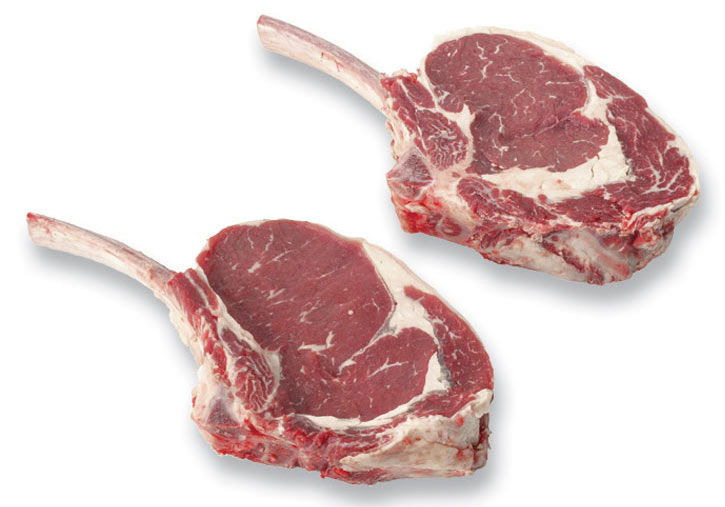
Technical Description – The Frenched bone-in rib steak is the same as NAMP #1103 Bone-in Rib Steak, but each steak is cut between the rib bones. The rib bone is completely trimmed of the intercostal meat, lean and fat, so that the bone is exposed from the ventral edge of the longissimus dorsi to the end of the rib bone.
The Frenched bone-in rib steak is commonly referred to as “Tomahawk” or “Cowboy Steak” and has become increasingly popular because these steaks can create excitement, with weights of up to 0.9 kg (2 lb).
Traditional bone-in “Tomahawk” steaks are difficult to manufacture as most large meat plants will not sell ribs with the extra short rib needed to make a dramatically long bone “tomahawk.” Generally, a retailer would have to source from a smaller harvest facility to find this specification.
Smaller Frenched bone-in steaks can be manufactured from the regular bone-in prime ribs by cutting between the bone with your knife and then removing the meat from the bone at the tail end. These bone-in prime rib steaks could be sold as Prime Rib Mini Tomahawk Steaks, and will create a point of differentiation in your meat case.
Some distributors are starting to manufacture prime rib tomahawk steaks for their clients but this is more common in foodservice.
Cooking Methods
Grilling
Applications
Steaks
Resources
Rib Steak (Boneless)
Rib Steak (Boneless)
NAMP #1112A
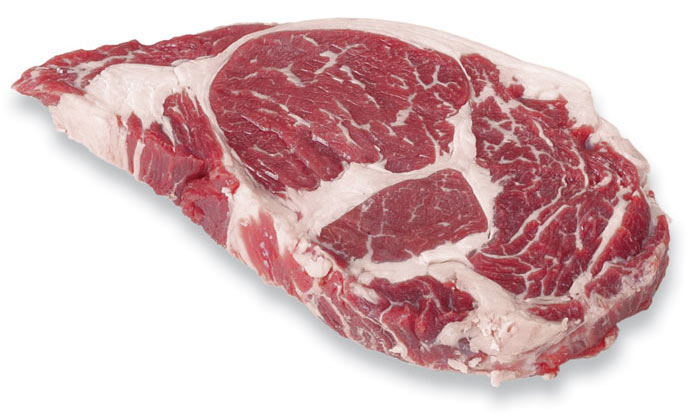
The boneless rib steak is prepared exactly as bone-in rib steak except that all other bones, cartilages and the intercostal meat are removed.
Boneless rib steaks are not a common retail product as a retailer can process a more acceptable rib eye steak by removing the tail meat. Rib eyes are more familiar to most retail customers and command a higher price point at retail.
Cooking Methods
Grilling
Applications
Steaks
Resources
Rib Eye Steak
Rib Eye Steak
NAMP #1112
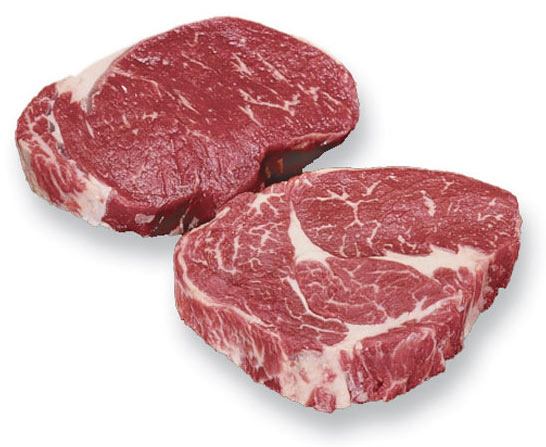
Technical Description – Rib eye steak is prepared from a rib eye with not more than 6 mm (1/4″) external fat; rib eye steaks will have no evidence of tail meat in the retail market (as dictated by the CFIA).
Rib eye steaks are a classic steak sold in most retail meat operations. Rib eyes are usually well marbled and deliver intense rich beef flavour. Rib eyes have been part of most retail operations’ product mix for many decades, and they command a very high retail price because of the flavour and tenderness of this section of the beef animal.
Cooking Methods
Grilling
Applications
Steaks
Resources
Rib Eye Cap Steak and Roast
Rib Eye Cap Steak and Roast
NAMP #1112D
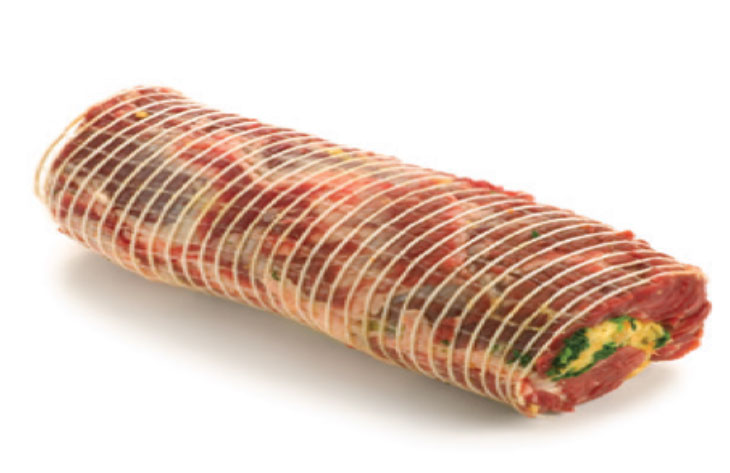
Technical Description – Boneless rib eye cap steak or roast is prepared from the spinalis dorsi/multifidus dorsi muscle from any rib eye roll items. For portioning, slice the rib eye cap at a right angle to the grain or direction of the muscle fibres. Please watch the video on the Prime Rib to understand how to manufacture the spinalis into roasts and steaks from the prime rib.
Boneless rib eye cap steak is commonly known as spinalis steak and is being sold by large meat retailers in the United States. The spinalis has also gained popularity among some progressive foodservice companies. As noted earlier this product should be introduced via the service meat case, as it may warrant explanation as to where it comes from and how to cook it. Due to the additional labour required and its value impact on the traditional primal rib, boneless rib eye cap steak requires a higher retail price point to drive profitability.
Resources
Rib Eye cap Steak or Roast (Spinalis) Tech Sheet
Rib Eye Medallion
Rib Eye Medallion
NAMP #112C – Component
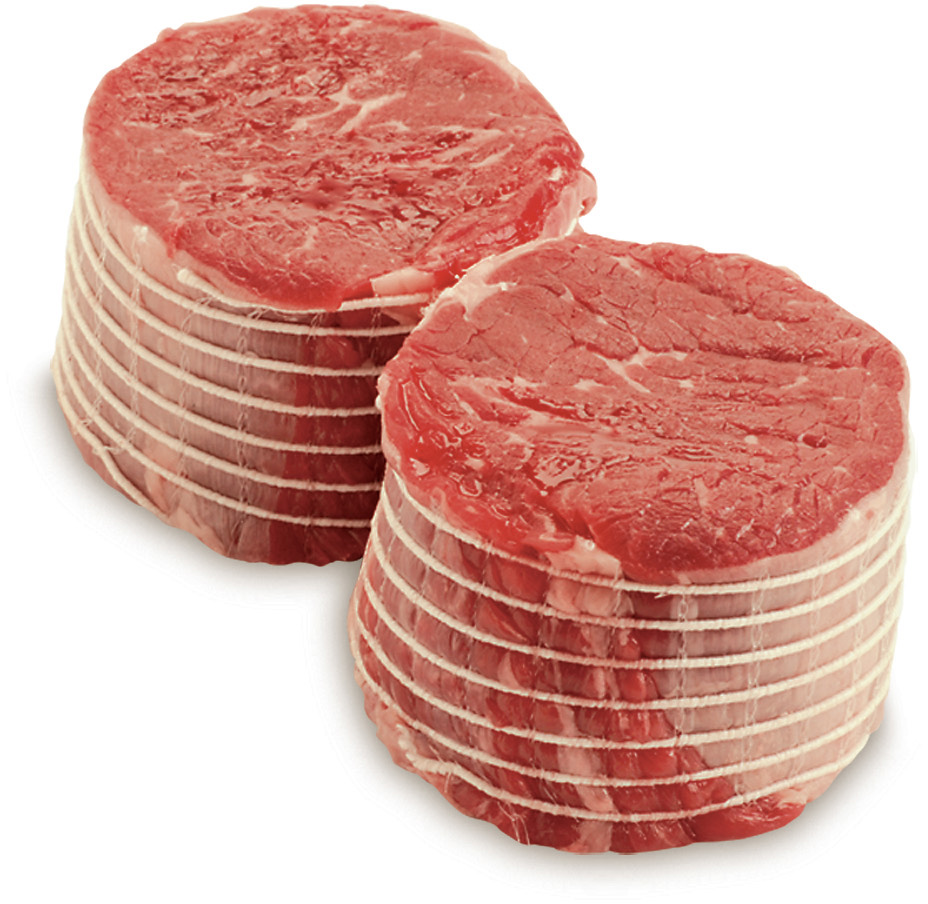
The rib eye medallion can be processed from any of the whole muscle specifications that we have discussed in this section, but heavier ribs work best for this application: 6.7 kg (15 lb) and up. The first step is to remove the spinalis dorsi, or cap muscle, and any finger meat from the rib. This exposes the fat kernel, which should also be removed. The tail on the rib should be removed leaving the main muscle (longissimus), which is tapered in shape. The main muscle is cut where the muscle tapers, leaving two pieces. The larger piece is split lengthwise, resulting in three equal-sized pieces that can then be portioned into thick-cut medallions. Effective use of this beef cut relies on the ability to add value to the cap muscle that was removed during the production of the medallions. The cap muscle (spinalis dorsi) can be utilized by rolling (stuffing optional) and netting, maximizing the yield and creating new menu opportunities.
The rib eye medallion merchandising concept creates a steak option which is smaller than a traditional rib eye. Steaks that are smaller can create a thicker, more affordable option for the customer. The medallion steak is very attractive and commands a higher price point. Left as a roast, it creates a quick-roast option which can be cut to about 0.5 kg (1 lb), which meets the needs of many retail customers: Easy to cook, easy to carve and the right size for two or three people.
Cooking Methods
Grilling
Applications
Steaks
Resources
Chatea Cut Rib Eye Medallion Tech Sheet
Chuck Roll
Chuck Roll
NAMP #116A

Technical Description – The chuck roll is prepared from a neck of boneless, square-cut chuck and consists only of the large muscle system that lies under the blade bone. The arm portion is excluded by a straight cut that is not more than 7.5 cm (3″) at the rib end and not more than 10 cm (4″) at the neck end. Any cartilages, back strap, trapeziusm supraspinatus, intercostals meat and lymph glands are also excluded. When smaller roasts are specified, the boneless chuck roll is divided into equal portions by cutting through the meat perpendicular to the length of the chuck roll. This item may be netted or tied when specified. The chuck roll weighs between 7 – 9 kg (15 – 20 lb).
The chuck roll is sometimes called the bottom blade or boneless blade. Chuck roll is usually supplied vacuum sealed and packed 2 – 3 rolls per case.
The chuck roll has an abundance of marbling throughout the muscle, and can be braised whole, processed into simmering or marinating steaks, or manufactured into pot roasts. Because of the marbling in the chuck roll, the trim makes an excellent source grind that can be called Ground Chuck. The trim can also be used for making a superior beef sausage or value-added meat balls and meat loaf. Remember that if you are making a true beef sausage, no other proteins (except ground veal) can be used and the sausage must be stuffed into a collagen casing.
Traditionally the chuck roll has been used by retailers for bottom blade steaks and bottom blade roasts.
There are other options that can be used if the chuck roll is muscle-cut into different sections, which includes the Delmonico, the Sierra and the chuck flat. These sections comprise about a third of the chuck roll and will add tremendous value to any meat operation.
Included at the bottom of this segment is a link to a video that shows how to manufacture these cuts. The chuck roll is about a third the price of middle cuts such as the prime rib and the loin.
Creating value by merchandising these cuts will create a point of differentiation in your meat operation from other retailers. Remember that it is important to have proper nomenclature to correspond with regulations from the CFIA in Canada.
If you sell these cuts they must have Chuck Bottom Blade in the name. In the case of Delmonico or Sierra, it would state Chuck Bottom Blade Delmonico Steak or Chuck Bottom Blade Sierra Steak. The chuck flat has incredible marbling and can be merchandised in the meat case as Chuck Bottom Blade Short Rib or Chuck Bottom Blade Montreal Steak.
After harvesting these cuts, the remaining chuck roll can be manufactured into bottom blade roasts, stew beef and short ribs. It does take a little bit of practice to manufacture these hidden gems, but it is well worth the effort from both a merchandising and profit perspective.
Cooking Methods
Pot Roasting
Braising/Simmering
Applications
Roasts
Clod Roast
Blade Eye Roast
Restructured Roasts and Products
Cooked Pot Roast
Seasoned Roasts
Top Blade Flat Iron Chuck Roll Mock Tender Tech Sheet
Top Blade (Chuck Tender)
Top Blade (Chuck Tender)
NAMP #116B

Technical Description – Top blade (chuck tender) consists of the supraspinatus muscle, which lies dorsal to the medial ridge of the blade bone. The chuck tender is separated from the other muscles through the natural seam. The heavy connective tissue on the thick end of the chuck tender should be exposed and removed. The chuck tender weighs between 2 – 3 kg (4.5 – 6.5 lb).
Chuck tenders are supplied individually vacuum sealed, and usually packed 5 – 10 tenders per case.
The chuck tender is also known as a mock tender, as it is shaped like the tenderloin butt. Other names include Scotch tender or top blade.
Chuck tender is an excellent item for braising or stewing.
The chuck tender creates an opportunity to have braising steaks and braising roasts as part of your winter beef product mix. These are relatively easy to manufacture with very little yield loss and can be purchased at a very attractive price point. Stew manufactured from the chuck tender is very attractive and as the muscle in the chuck tender is tough (which imparts flavour from the collagen and connective tissue), this creates a sensational finished stew dish when prepared properly by your customers. The name mock tender comes from the fact that the mock tender looks similar to a beef butt tenderloin and has been mistaken by meat personnel as tenderloin and cut and labelled as beef tenderloin. It is a mistake that will lose customers, so make sure the product is labelled and merchandised properly in the meat case and labelled properly in storage.
Cooking Methods
Pot Roasting
Braising/Simmering
Applications
Braised Roasts
Chuck Tail Flat
Chuck Tail Flat
NAMP #116G
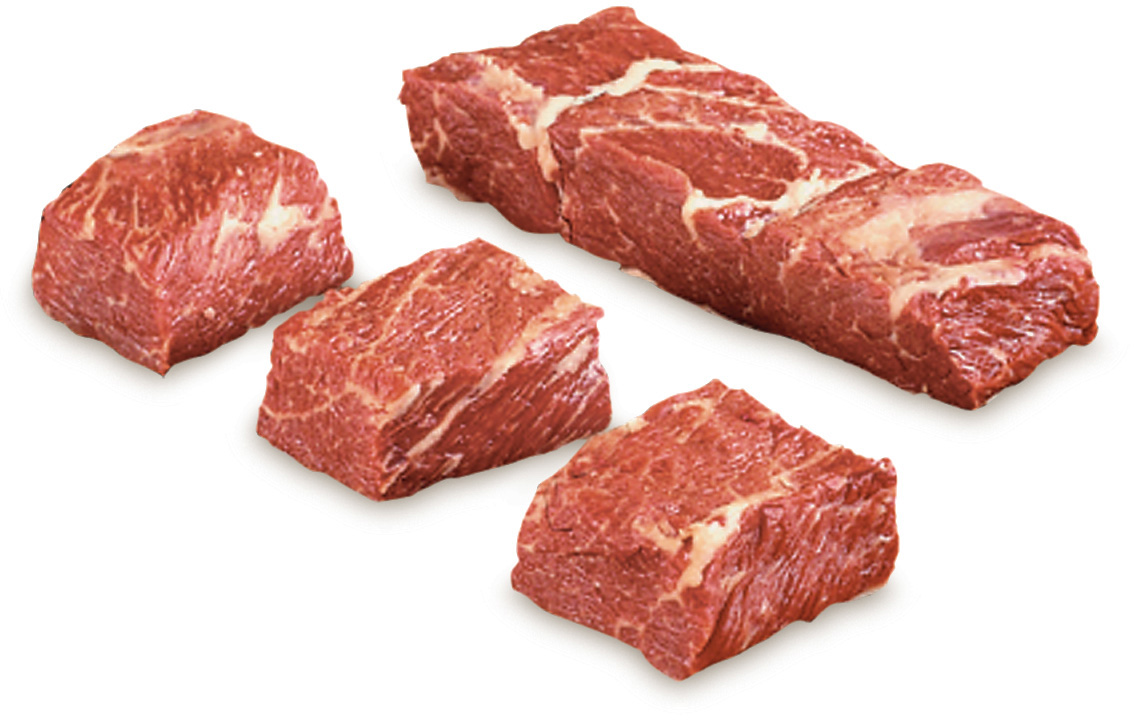
Technical Description – Chuck tail flat consists of the serratis ventralis muscle. The fat coverage should be minimal with all heavy connective tissue removed and no ragged edges. The bone-in version of the chuck tail flat is the chuck short rib.
The chuck tail flat is also known as a Denver or Montreal steak. If you merchandise it as a steak you should have Chuck Bottom Blade Montreal or Denver Steak in the name on the label.
Some meat operations will merchandise the chuck tail flat as a boneless short rib and this is an excellent option for your meat case in the wintertime. Customers will be happy with either option as this is a nicely shaped and attractive product that performs well both as a steak and a short rib.
This option was also profiled in the chuck roll section as the chuck flat extends into the chuck roll and can be also harvested from the chuck roll.
Cooking Methods
Grilling
Applications
Sandwich Steaks
Strips for Stir Fry
Top Blade Flat Iron Chuck Roll Mock Tender Tech Sheet
Shoulder Clod
Shoulder Clod
NAMP #114E
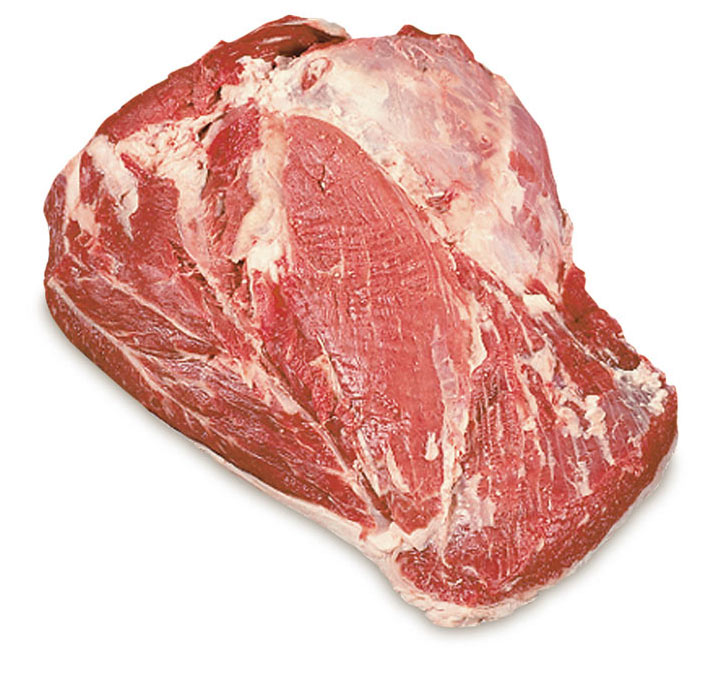
Technical Description – Shoulder clod is prepared from the large muscle, posterior to the elbow joint in the chuck. The overlying fat is trimmed to an average fat cover of 6 mm (1/4″). The inside is trimmed of all heavy tissue covering the lean, where it is attached to the shoulder blade. All ragged edges and loose meat is trimmed off. Shoulder clod weight range is 2.8 – 4.6 kg (6 – 10 lb).
The shoulder clod can be ordered with two specifications. The long cut shoulder clod NAMP #114 contains the flat iron, petite tender and the shoulder clod muscles. It requires butchery skill to separate and merchandise these cuts. These cuts can also be sourced individually and the short cut shoulder clod NAMP #114 E is profiled in the picture above.
Traditionally the shoulder clod has been processed for chuck shoulder cross rib roasts or steaks and has been merchandised in the Canadian winter as a braising roast or steak. New cutting concepts separating the top clod muscle from the clod heart or centre clod have created some options for steaks that can be used in the summer time to ease the pressure of sourcing steaks at a reasonable price.
It should be noted that the separation of the two muscles in the clod takes some practice but it does yield profitable results as steaks, if cut across the grain properly, as either traditional cross rib steaks or medallions.
If a retail operation uses the short cut clod in the traditional manner, as a braised product, it might be a good idea to manufacture rotisserie-shaped roasts out of the clod that would be more consumer friendly. To see how the clod can be separated into the top clod and clod centre and further manufactured into steaks, please watch the video in the resource section below.
The best cooking results for shoulder clod are obtained through braising or simmering.
Shoulder clod has an extremely good price point value and is an excellent option for retail operations whose customers are looking for traditional braising options or customers who are looking for new cut concepts such as chuck shoulder clod medallions. These cuts will create a point of differentiation from your competitors as well as increase your profit margins as this is an inexpensive section of the beef animal. Remember that sections from the shoulder are viable options to meet the seasonal needs of your meat case as we transition into the winter months in Canada. Trim from the clod can also be used to create source-specific, value-added products using the chuck cache. Shoulder clod is from the chuck area of the carcass, which creates an upsell through a higher quality perception recognized by the great flavour which chuck delivers. Another excellent option for trim from the clod would be for stew beef.
Cooking Methods
Pot Roasting
Braising/Simmering
Applications
Pot Roast
Sandwich
Shoulder Clod Clod Tender Tech Sheet
Top Blade (Flat Iron Steaks)
Top Blade (Flat Iron Steaks)
NAMP #1114D
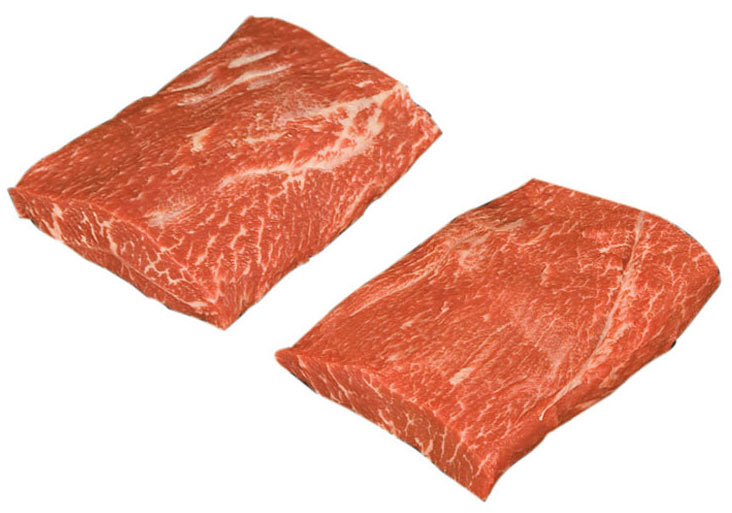
Technical Description – Top blade, or flat iron steak, is prepared from the shoulder clod consisting of the infraspinatus muscle. For the best eating experience, remove the heavy connective tissue running through the length of the muscle by seaming from end to end.
Top blade, or flat iron steak, is nearly identical to NAMP #114D Shoulder (clod), top blade but is sold pre-portioned.
Cooking Methods
Grilling
Applications
Steaks
Top Blade Flat Iron Chuck Roll Mock Tender Tech Sheet
Clod Tender
Clod Tender
NAMP #114F
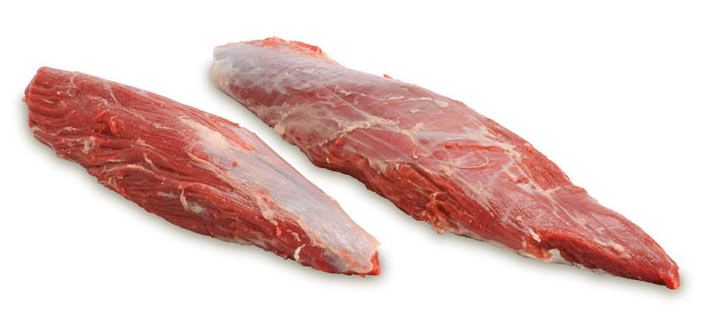
Technical Description – The teres major muscle is produced when making the clod tender. The small, cone-shaped muscle lies just beneath the triceps brachii, as well as under and to the posterior edge of the scapula/blade bone. The muscle fibres run parallel to the long axis of this muscle, which may have some connective tissue on its external side. Clod tender is trimmed to the silver, with flake fat allowed. The clod tender weighs between 0.4 – 0.7 kg (0.8 – 1.5 lb).
Clod tender is usually supplied vacuum sealed approximately 10 clod tenders per bag, packed 3 bags per case.
Clod tender is also known as petite tender, shoulder tender or teres major.
Clod tender is another hidden gem on the chuck area of the beef carcass. It is a small very tender muscle with consistent grain found on the top side of the shoulder clod.
Only a small amount of trimming of silver skin is required to make the clod tender grill or roast ready.
The clod tender is an excellent muscle for small grilling medallions or it can be grilled or roasted whole.
When describing how to cook the clod tender to your customer, remember to tell them to not cook this muscle past medium as there is not a lot of marbling, and the clod tender will dry out and toughen when cooked past 60°C (140°F).
Some progressive retailers have used the clod tender (petite tender) to manufacture Beef Wellingtons which they sell in their service meat case or deli. Other options with the clod are to create Bacon Wrapped Beef Roasts or Bacon Wrapped Beef Medallions. As a hidden gem, adding value is made simple. An example is a football roast. By cutting a slit down the centre of the clod, a stuffing can be introduced: Use toothpicks to secure the stuffed opening and then tie a string, football style, across the toothpicks to hold the stuffing intact. This process transforms a simple product into a game-day special and brings excitement to your service meat case. Some retailers are using the petite tender for their beef kebab program as the muscle is the perfect size and tenderness to produce a consistently tender, evenly sized beef kebab every time. Please view the linked video to help you understand the merchandising potential of this versatile and tender cut of meat.
Cooking Methods
Grilling
Sauté/Pan Fry
Oven Roasting
Braising, Simmering, Stewing or Pot Roasting
Rotisserie
Applications
Steaks
Roasts
Shoulder Clod Clod Tender Tech Sheet
Diced Beef
Diced Beef
NAMP #135A
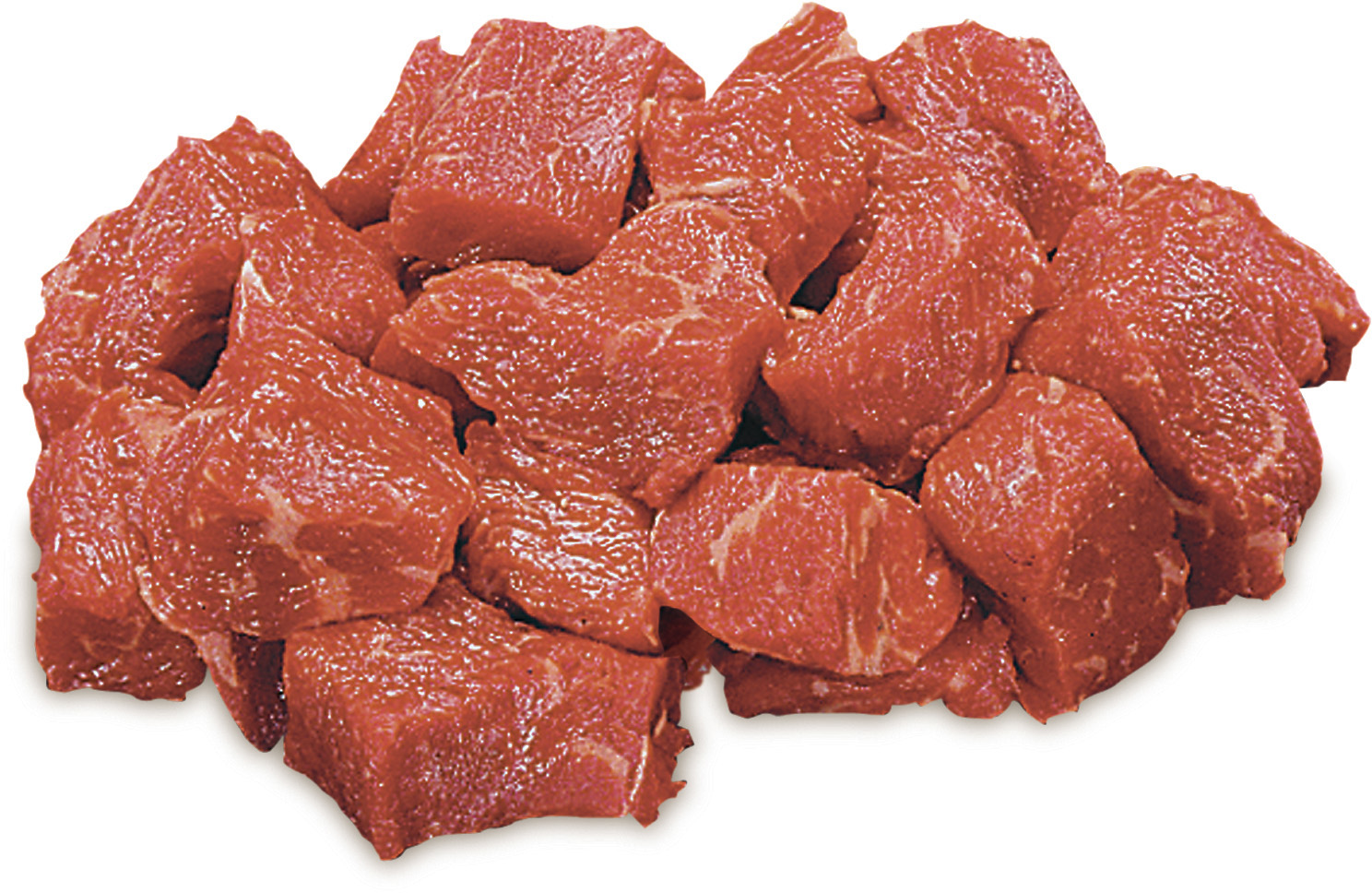
Technical Description – Diced beef is prepared from any part of the carcass trimmed free of bones, cartilage, fibrous and membranous tissue, exposed major blood vessels, glands and blood clots. Meat from heads, gullets, tongues, and glands is not used. All external and exposed internal fat is trimmed to achieve a chemical lean of 85%. The meat is machined or hand-diced to produce reasonably uniform pieces.
Cooking Methods
Stewing
Applications
Stews
Casseroles
Kabobs
Meat Pies
Beef Marinating Strips
Beef Marinating Strips
NAMP #612
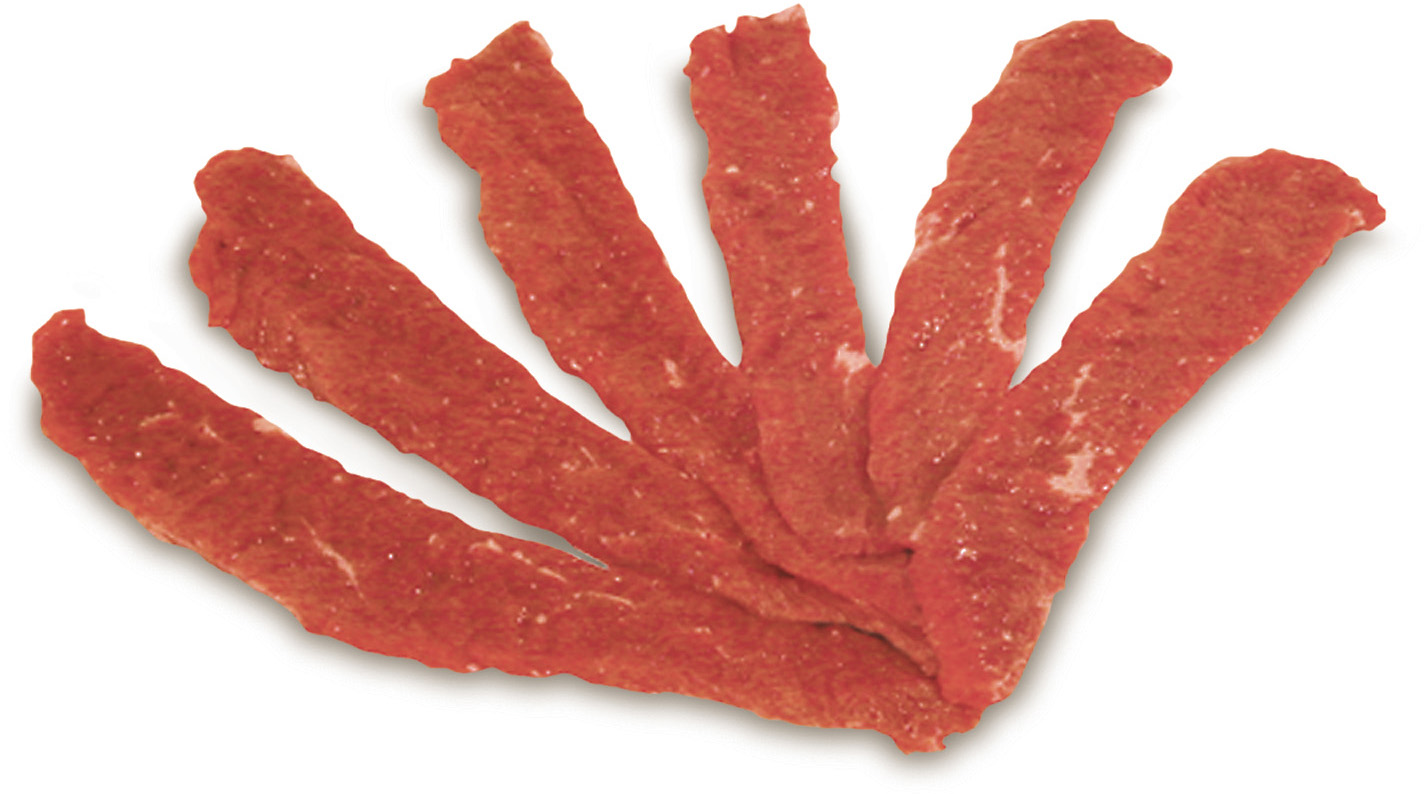
Technical Description – Beef marinating trips may be produced from any raw skeletal portion of the beef carcass with the exception of the cutaneous, shank, and heel meat portions. The meat shall be practically free of fat and shall be marinated or seasoned as requested.
Common names include beef marinating stir-fry strips or fajita strips.
Cooking Methods
Sauté/Pan Fry
Stewing
Applications
Stir Fry
Fajita
Salads
Pizza Topping
Appetizers
Wraps
Flank Steak
Flank Steak
NAMP #193
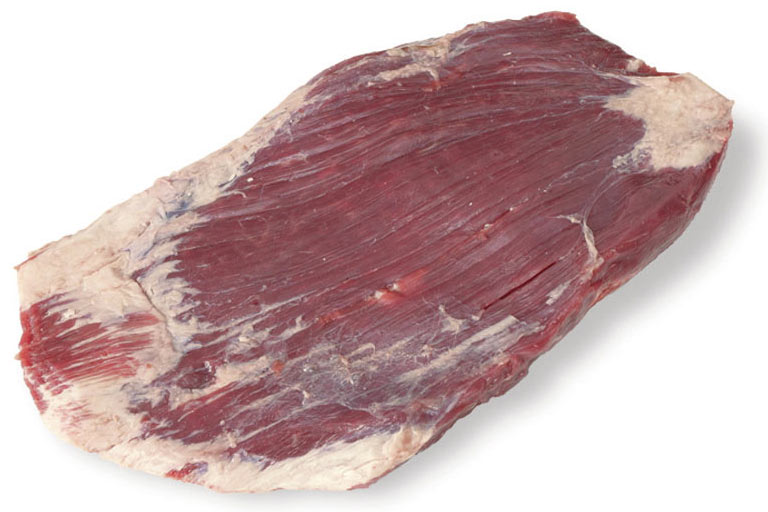
Technical Description – Flank steak is prepared from the single, oval-shaped muscle located on the posterior inside of the flank piece. The trimmed steak will be free of fat, except for minute flecks that adhere loosely to the lean. The flank steak consists of the rectus abdominis muscle from the flank region of the carcass. Flank steak weighs approximately 1 kg (2.2 lb).
Flank steak is usually supplied vacuum sealed 5 flank steaks per bag, packed 3 bags per case.
The flank has excellent yield and is simple for the meat cutter to prepare for sale. Flank steaks typically only need trimming of silver skin, fat and ragged edges.
Another method of preparing flanks for retail sale is to score the outside with a knife, making hatch marks for penetration of a marinade. In some retail operations flanks are marinated and sold in a vacuum bag with spices and marinade in the bag.
A common method of creating a value-added product with the flank is to run the flank through a tenderizing machine and then welding two or three flank steaks by pressing the muscles together with your fingers. A stuffing is then introduced on top of the steaks (bread stuffing, parmesan cheese, mild Italian sausage and fresh spinach are examples of stuffing mixtures). The flanks are then rolled up to form a log, tied with butcher string and sold as a stuffed roast or more commonly cut into medallions approximately 5 cm (2″) thick. This is a variation of London Broil, which is a flank that is stuffed and rolled with a thin layer of fat on the inside.
The flank steak gained popularity because of Hispanic- and Asian-inspired dishes that were derived from this section. Remember to tell your customer to carve the finished cooked product thinly across the grain on a bias (45° angle) for best results.
Cooking Methods
Grilling
Smoking
Sauté/Pan Fry
Oven Roasting
Braising, Simmering, Stewing or Pot Roasting
Applications
Steaks
Strips for Stir Fry
Salted/Pickled Beef
Beef Bacon
Resources
Short Ribs (Beef Chuck Four Bone)
Short Ribs (Beef Chuck Four Bone)
NAMP #130

Technical Description – This cut is generated from rib bones of the primal chuck. This includes 4 ribs (2nd to 5th rib) that sit directly over top of the chuck clod.
Both short ribs can be used for the same application, but it should be noted that the chuck four bone short rib is often priced at a discount and performs very well from a yield and merchandising perspective in retail meat operations. Both options are very accessible and create wonderful merchandising opportunities in retail meat operations.
Short Ribs (Three Bone)
Short Ribs (Three Bone)
NAMP #123
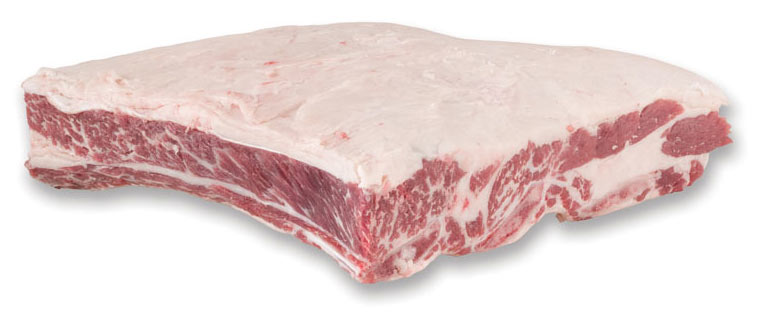
Technical Description – Short ribs consist of the portion of the forequarter immediately below the primal rib. The flank follows the natural curvature of the 12th rib. Short ribs may include ribs 6 through 12.
Note that Short Ribs NAMP #123 are ribs 6 through 9.
A better option for retail meat operations may be short rib NAMP #130, which are ribs 2 through 5. These short ribs are leaner and meatier, as they come from on top of the clod. This item is featured in the video below.
Short ribs are usually supplied vacuum sealed 2 short ribs per bag, packed 4 – 5 bags per case.
Short ribs are an excellent product that can be used as a thick-cut braising product or cut thin and sold as a marinade and grilling option. Some retailers are applying the marinade and then selling them as a value-added product in the hot deli and/or in the service meat cases as a vacuum sealed or overwrapped offering. A great value-added item when introducing an Asian theme to the meat case.
The braising technique is best suited for cooking thicker-style short ribs.
Braising ribs (chunky style) are best sold in the wintertime, and thin-style grilling marinade ribs (sometimes known as Maui Ribs) are an excellent product to introduce into your summer product mix.
Cooking Methods
Grilling
Smoking
Braising, Simmering, Stewing or Pot Roasting
Applications
Rich, flavourful entree
Korean Style Ribs
Maui Ribs
Short Ribs, Boneless
Short Ribs, Boneless
NAMP #123D
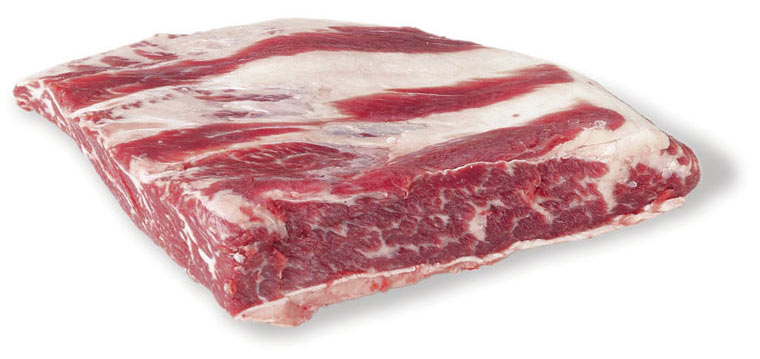
Technical Description – Boneless short ribs consist of the serratus ventralis muscle from any short rib item. The rib bones and intercostal meat is excluded.
This is same item as NAMP #123 Short Ribs, but boneless. Most chefs prefer to serve short ribs with the bone.
Boneless short ribs are not as common in retail as in foodservice. Although this is a viable option, there remains a better boneless option such as the chuck flat that was profiled earlier in this course.
Cooking Methods
Grilling
Smoking
Braising, Simmering, Stewing or Pot Roasting
Applications
Rich, flavourful entree
Korean Style Ribs
Maui Ribs
Short Ribs (Sliced)
Short Ribs (Sliced)
NAMP #1123B

Technical Description – Sliced short ribs are prepared from the short plate rib by removing the first layer of fat and lean. When ordering sliced short ribs, the number and length of ribs must be specified and may include ribs 6 through 12.
Short ribs may be purchased to various portion sizes, including number of bones as well as thickness.
You may hear short ribs referred to as “Miami Ribs” or “Korean Ribs,” which are a thinner cut of short ribs.
Cooking Methods
Grilling
Braising/Simmering
Applications
Rich, flavourful entree
BBQ Ribs
Smoked Cooked Ribs
Appetizers
Outside Skirt
Outside Skirt
NAMP #121C
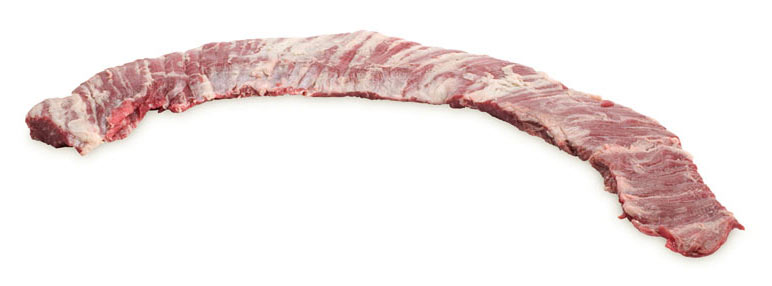
Technical Description – Outside skirt is prepared from the diaphragm muscle only, which may have the serous membrane attached. The membrane is trimmed close to lean. The outside skirt weighs approximately 0.8 kg (1.75 lb).
Outside skirt is usually supplied vacuum sealed 5 skirts per bag, packed 3 bags per case.
The outside skirt is usually scored, marinated and roasted or grilled whole.
Outside skirt may be used as a steak option, as fajita meat, or as a salad topping.
The skirt meat options and the hanging tender options are not handled by most retailers in Canada. Until beef markets opened up in Hispanic countries such as Mexico, most of the thin cuts from the beef carcass were used for grinds. With the advent of the Food Network Canada and new cuisines, some retailers are looking for cuts that might differentiate their stores from competitors and thin meats may create this opportunity.
It is critical that these products be introduced into a meat operation after the staff is fully familiar with the preparation methods from both the butchery and cooking perspectives.
While these are wonderful products, it is critical that they are prepared and cooked properly for best results.
Cooking Methods
Grilling
Smoking
Sauté/Pan Fry
Braising, Simmering, Stewing or Pot Roasting
Applications
Fajita
Satays
Skirt Steak
Carne Asada for Latin dishes
Pulled Beef
Resources
Inside Skirt
Inside Skirt
NAMP #121D
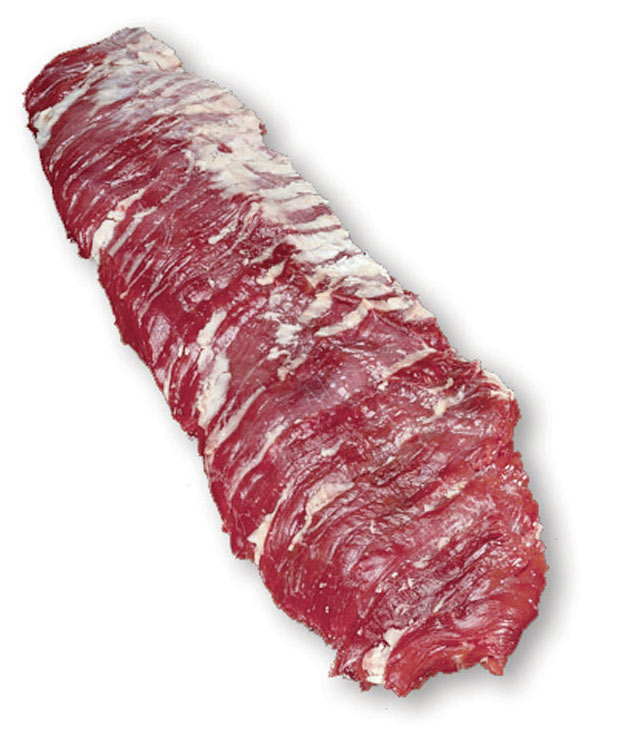
Technical Description – Inside skirt consists of the transveris abdominal muscle, with the serous membrane (peritoneum) removed. The lean surface is trimmed practically free of fat. Inside skirt weighs approximately 0.9 kg (2 lb).
Inside skirt is usually vacuum sealed 5 skirts per bag, packed 3 bags per case.
Inside skirt is a good option for its price point and has some excellent cooking qualities that are similar to the flank steak.
Inside skirt is easy to trim of excessive fat and membrane, and yields very well.
Like flank steak, inside skirt is usually scored before marinating or before grilling or roasting.
The inside skirt may be used as a steak option, as fajita meat, and in salads.
The inside skirt can usually be sourced as a less expensive alternative to the outside skirt.
Both the inside and outside skirt can be ordered as a denuded or undenuded option.
It might be a good idea to do a simple time-in-motion test as well as yield test to see which option works best for your meat operation.
Cooking Methods
Grilling
Smoking
Sauté/Pan Fry
Braising, Simmering, Stewing or Pot Roasting
Applications
Fajita
Satays
Skirt Steak
Carne Asada for Latin dishes
Pulled Beef
Resources
Hanging Tender
Hanging Tender
NAMP #140
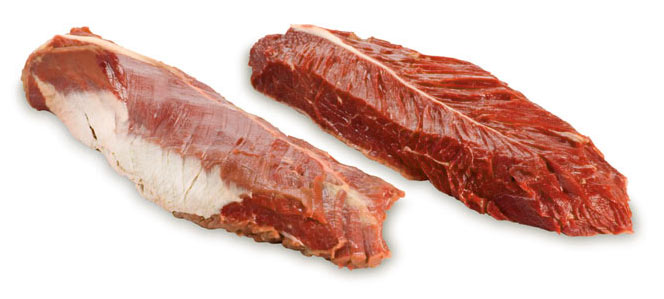
Technical Description – The hanging tender is a soft, grainy-textured, elliptical-shaped muscle that is attached to the diaphragm and the juncture of the lumbar/thoriacic vertebrae. There is only one hanging tender per carcass. Hanging tender is also known as hanger steak or thick skirt and has similar characteristics to inside and outside skirt.
Hanging tender may be difficult to source.
There is only one hanger steak on each carcass which in itself is unique. Hanger steaks usually weigh between 1.5 – 2.5 kg (3.3 – 5.5 lb).
It is critical to remove the middle elastin gristle line that runs through the centre of the hanger steak. Once this is removed the hanger can be processed into portions that should be marinated and grilled for best results. This is truly a unique section and sometimes has a bit of an organ taste profile.
Similar to all thin cuts, it is important for the customer to carve the hanger steak thinly, across the grain and on a bias or 45° angle.
The hanger steak will create a level of interest from your customers and it is important to be able to describe the cooking and carving requirements for this cut to them.
All of the thin cuts described in this section will provide a point of differentiation in the retail meat case. Opportunities for marinating programs are evident and this is a great opportunity to explore these cuts in your service meat case.
Brisket
Brisket
NAMP #120
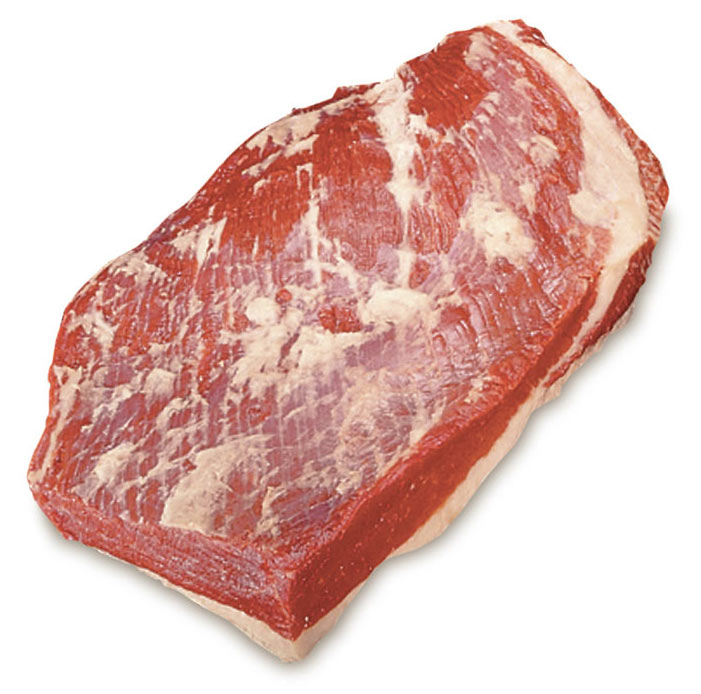
Technical Description – Brisket is prepared from the boneless brisket. The fat along the sternum edge is trimmed at the top within 6 mm (1/4″) of the lean meat. The deckle and thick layer of fat are removed along its natural seam. The inside surface must be free of all loose fat, gristle, ragged meat and bone cartilage. The outside fat cover is trimmed to an average 6 mm (1/4″). The tapered end is cut square to the sides and must show at least 12 mm (1/2″) lean and not more than 6 mm (1/4″) of fat. Brisket weighs between 4.4 – 5.4 kg (10 – 12 lb).
Briskets are supplied vacuum sealed and packed 5 – 6 briskets per case. Briskets are also purchased vacuum sealed in brine and cooked as corned beef.
This is often referred to as the Brisket Point.
There are other, less common brisket trim variations including NAMP #118 Bone-in Brisket, NAMP #120A Brisket Boneless Deckle Off and NAMP #120B, Brisket Point Cut, Boneless.
The brisket is considered a tougher section of the carcass, and contains a substantive amount of connective tissue and fat.
The brisket is a desirable muscle if prepared properly, and is an excellent price point value.
The best cooking application for the brisket is to apply a rub and cook the brisket “low and slow” for an extended period of time. It is critical that front-line staff in a meat department are able to convey this to their customers. Examples of these cooking techniques are pot roasting, stewing and American Style BBQ in a smokehouse.
A growing trend in Canada is the slow cooking movement. An application of slow cooking is the American BBQ. In the United States, BBQ is a bit of a cult and the king of the BBQ is the brisket. There are national competitions and a lot of hype around BBQ with many different recipes for BBQ brisket. For an exceptional product, a rub is often put on the outside of the brisket and vigorously applied. The brisket is cooked in a smokehouse at a temperature of about 107°C (225°F) for 12-14 hours to an internal temperature of 96.1°C (205°F). Remove the brisket at about 94°C (200°F). The brisket is rested for 30 minutes to an hour and then carved across the grain. Done properly this is an exceptional eating experience and will appeal to the consumer looking to be a part of the slow cooking movement. Sourcing brisket at retail has been a challenge for tailgaters, foodies and meat hobbyists alike. The brisket may add additional meat sales for the slow cooking enthusiast.
The brisket is an excellent choice for braising applications and performs well because its connective tissue breaks down and creates a nice balance of fat to keep the meat moist and flavourful.
Brisket is also ideal for use in stews.
Brisket is also processed and sliced for Montreal corned beef, smoked meat and pastrami.
Cooking Methods
Grilling
Smoking
Braising, Simmering, Stewing or Pot Roasting
Applications
Sandwiches Carved Items
Pastrami NAMP #611s
Corned Beef NAMP #601s
Salted Beefs
Pickled Beefs
Shaved Meatss
Pulled Beef
Resources
Foreshank
Foreshank
NAMP #117
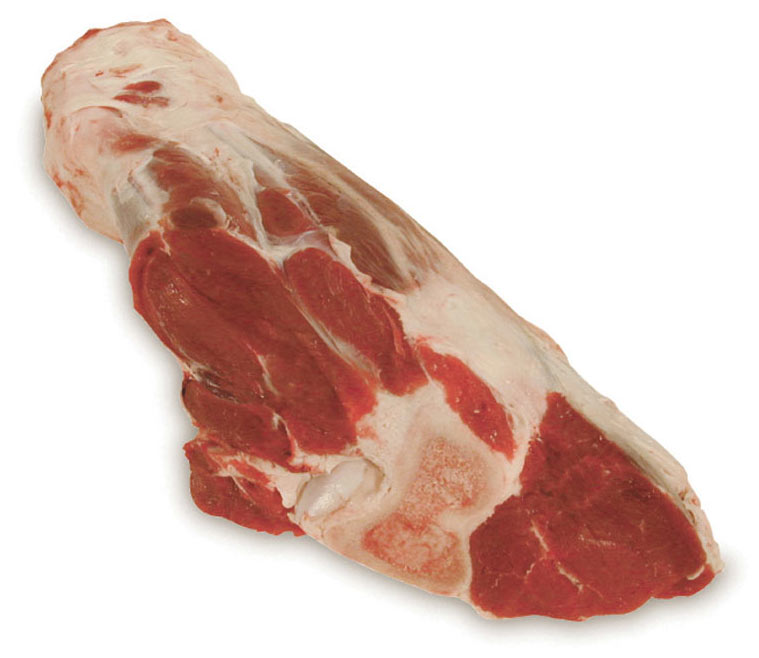
Technical Description – A bone-in foreshank is the item produced from a NAMP #120 Brisket after its separation from a square-cut chuck and brisket. The foreshank is made by a straight cut exposing a cross-section of the humurus bone. The brisket is excluded by a cut through the natural seam.
Shanks are usually supplied vacuumed sealed 2 shanks per package, packed 5 – 6 packages per case.
Shank meat has never been one of the most popular beef items in retail meat markets, but people who understand how to make a really good stew often purchase centre shank, traditionally in a bone-in format.
While there is a lot of connective tissue in the surrounding muscle, using a braising technique will solubilize and break down the tissue – imparting exceptional flavour and creating a wonderfully tender eating experience.
The bones in the foreshank and hind shank are marrow bones and they add another level of richness and elevated taste experience to a properly braised stew.
In Canada, beef shank prepared properly and displayed nicely can elevate meat sales and customer acceptance in the winter season.
Seasonal merchandising should be a careful consideration for all retailers in Canada.
Retailers should remember to remove all of the bone dust from the shanks as shanks are usually sold as bone-in products. Remember that comfort food (braised beef) rules in the winter.
Most shanks sold in retail meat operations are centre-cut shanks. The end bones or knuckles from the shank should be sold for producing soup stock or as pet food to your customers.
Cooking Methods
Stewing
Braising/Simmering
Applications
Stews
Braises
Beef Soups
Ground Beef Patties and Beef Burgers
Ground Beef Patties and Beef Burgers
NAMP #1136
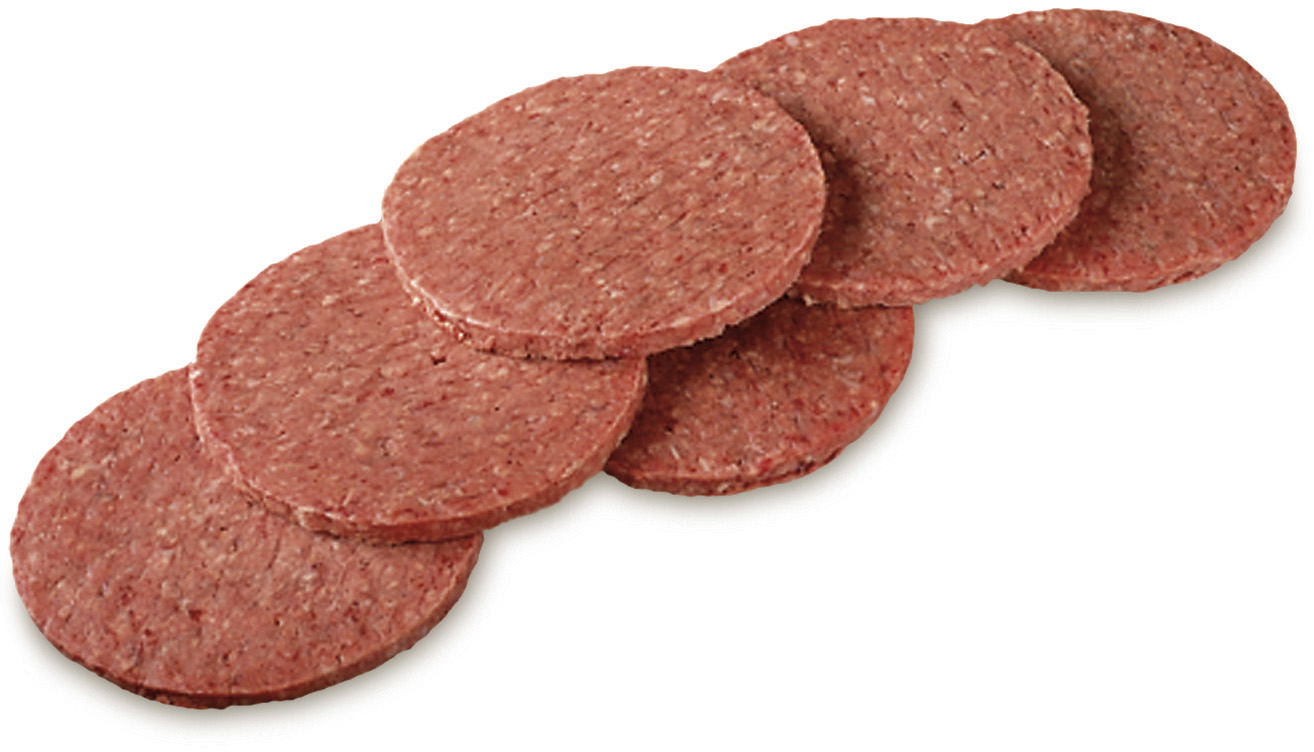
Technical Description – Burgers/Steakettes are prepared from ground beef, plus water, a filler (binder) sweetening agent, flavour enhancer, salt, spice and seasonings. Shaped into a specific form and mass. The minimum protein level will be at least 13% with the meat protein level being at least 11.5%.
Beef patties contain fresh boneless beef with optional seasoning and no fillers or binding agents.
Beef burgers contain fresh boneless beef with seasoning and filler or binding agents which are optional. Burgers may also be manufactured using mechanically separated beef as part of the beef blend.
Source-ground patties and burgers contain fresh beef trimmings from a particular primal (e.g., chuck or sirloin).
Cooking Methods
Grilling
Sauté/Pan Fry
Roasting
Applications
Hamburgers
Beef Sausage
Beef Sausage
NAMP n/a
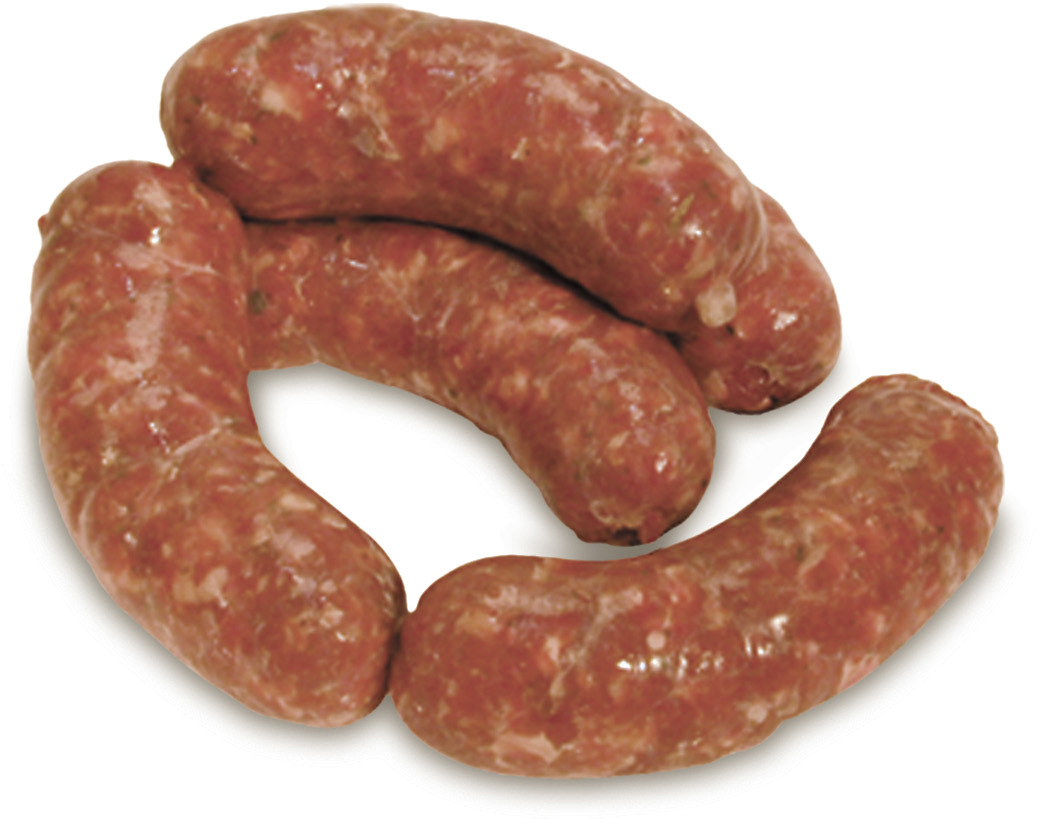
Technical Description – Beef sausage is made from fresh boneless beef or fresh mechanically separated beef, or any combination of the two. Specifications call for a minimum total protein of 9.0 % with a minimum meat protein of 7.5% and a maximum non-meat contribution of 1.5 % when sold as a raw meat product.
Ready-to-eat sausage (e.g., salami, wiener, frankfurter, pepperoni, liver sausage, bologna, mortadella) is prepared from boneless meat or meat byproduct or mechanically separated meat or any combination of the two. If the ready-to-eat sausage is cooked, then partially defatted beef is allowed.
Cooking Methods
Grilling
Sauté/Pan Fry
Roasting
Braising/Simmering
Applications
Pasta
Hot Dogs
Breakfast
Dinner

